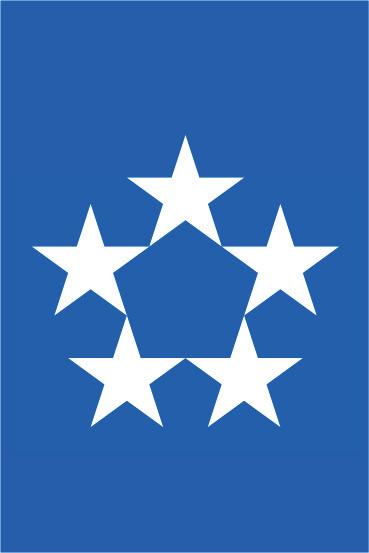
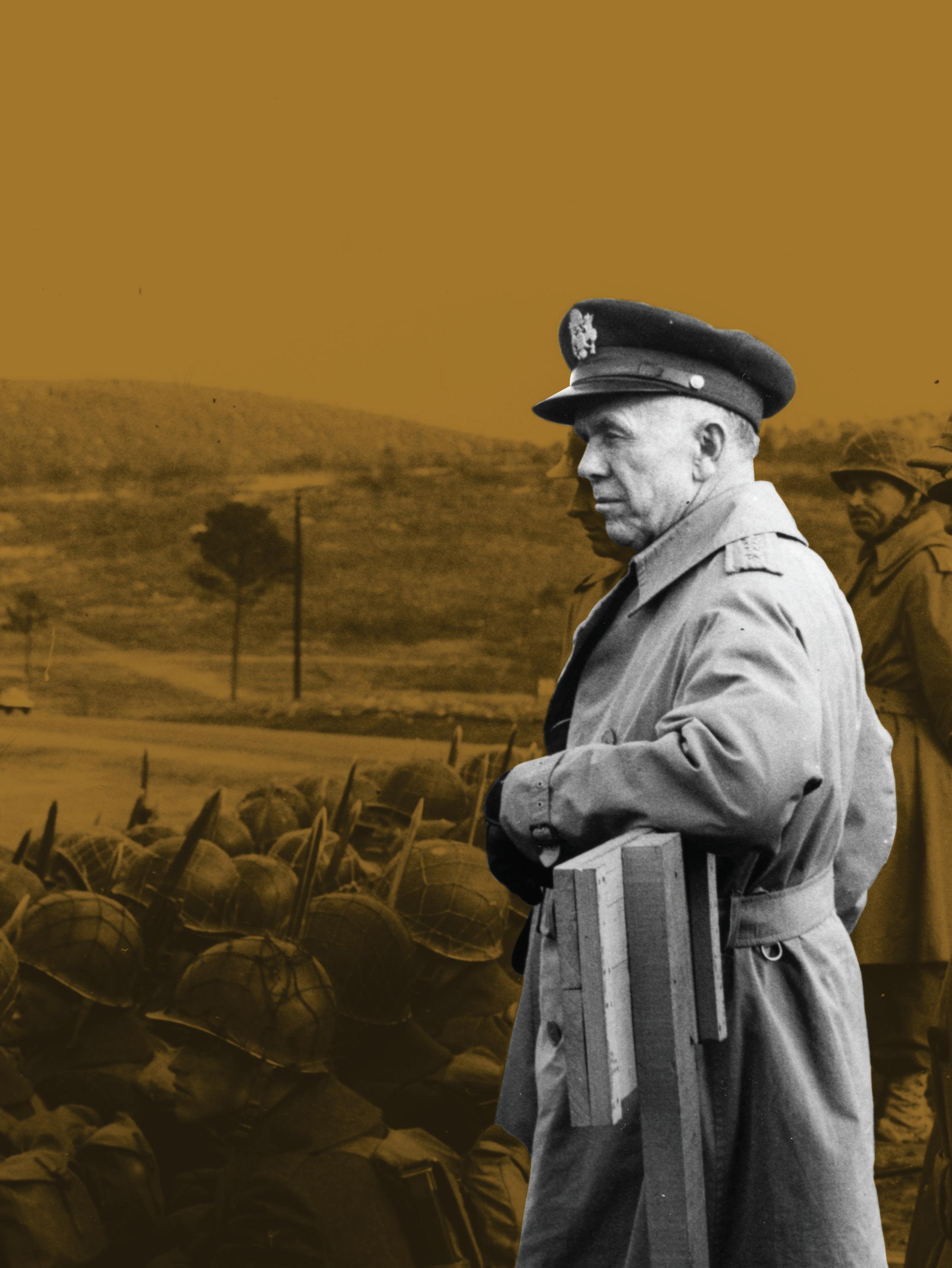
MARSHALL WINTER 2023
THE MAGAZINE OF THE GEORGE C. MARSHALL FOUNDATION
Frank McCarthy: The General Who Won an Oscar The Cold War Army in Germany Marshall in the Words of Others

Marshall is the magazine of the George C. Marshall Foundation. We encourage the reproduction and use of articles contained herein, as well as submissions. Direct correspondence and requests to P.O. Box 1600, Lexington, VA 24450.
Telephone: 540.463.7103
Website: www.marshallfoundation.org
Editor: Glen J. Carpenter
Email: editor@marshallfoundation.org
Contributors: Lt. Col. James Dittrich, USA (Ret.), Paul A. Levengood, Melissa H. Davis, Ashley Vance, Cody Youngblood
THE GENERAL WHO WON AN OSCAR by Lt. Col. James Dittrich, USA (Ret.) 4 BOOKS AND LECTURES 13 LETTER FROM THE PRESIDENT 3 MARSHALL IN THE WORDS OF OTHERS by Cody Youngblood 22 AN “ARMY ON THE ALERT” by Ashley Vance 14 HAPPY BIRTHDAY, GENERAL MARSHALL by Melissa H. Davis 36 Cover: Marshall
1943
watches over training exercises at Fort McClellan, Alabama,
Left:
Detail of a poster by Swiss artist Pierre Gauchat in support of the Marshall Plan, 1950
The most important factor of all is character, which involves integrity, unselfish and devoted purpose, a sturdiness of bearing when everything goes wrong and all are critical, and a willingness to sacrifice self in the interest of the common good.
George C. Marshall, March 15, 1944
2022 will go into the books as a memorable one for your George C. Marshall Foundation. It saw us host events around Virginia, in Richmond and Arlington, along with eleven in-person speakers here in Lexington. After the past two years, it was wonderful to see so many of our friends in person.
Meanwhile, the year also saw us launch a completely redesigned website and resume our role as a first-class research library, attracting students and scholars from all over the country. In addition, we kicked off our long-planned digitization program which will allow us to provide an unprecedented level of access.
The latter part of the year saw us hold our biggest awards ceremony in quite some time. On November 17, we honored two accomplished Americans at our George C. Marshall Foundation Awards in New York City: 66th Secretary of State Condoleezza Rice and Kenneth C. Griffin, founder of Citadel. On that glittering evening we were reminded that Marshall’s example still resonates, perhaps with greater relevance than ever.
In 2023 we plan to launch an outreach education initiative to the U.S. high school population. These programs will help students and teachers understand Marshall’s pivotal role in 20th century American and world history. We will also offer units on Marshall’s values and how they shaped him as a leader and a patriot.
None of this progress this year and promise for the future would be possible without your support. As a private non-profit, we rely on the generosity of our friends to ensure that we have the resources to carry out our vital mission and elevate the example of the man responsible for that stirring quotation above: George C. Marshall.
I hope that you and your family have a wonderful holiday season.
Best,
 Paul A. Levengood, President
Paul A. Levengood, President
3 LETTER FROM THE PRESIDENT
DEAR FRIENDS,

THE GENERAL WHO WON AN OSCAR
FRANK JOHNSON McCARTHY, JR.
by Lt. Col. James Dittrich, USA (Ret.)
Frank McCarthy heard the most powerful man in the United States military call for assistance and realized he was the only one in the office at the War Department who could respond. He was extremely nervous to be in the presence of the taciturn General George C. Marshall. Marshall was the army’s chief of staff in the fall of 1941, and he asked McCarthy if he could get him a ticket to the VMI football game being played nearby that weekend against Mary-
land. McCarthy called the visiting team and got a great seat. When he reported this to Marshall, the general suggested he get another ticket so they both could cheer for VMI. This was the start of a long-term friendship between Marshall and McCarthy that lasted until the former’s death in 1959.
Frank Johnson McCarthy, Jr., was born in Richmond, Virginia, on June 8, 1912. He grew up in a middle-class neighborhood where his
Opposite: Marshall pins
Distinguished Service Medal on Frank McCarthy, 1945
5 MARSHALL’S RIGHT-HAND MAN

father, Frank, Sr., worked as an agent for a life insurance company. His mother, Lillian, or Lil, came from the Binford family, prominent in the Virginia Tidewater region. Both his grandfathers were Confederate veterans. He had two younger brothers, Julien and William. Frank attended John Marshall High School in Richmond and was fifteen when his father died. He chose to attend the Virginia Military Institute because he was attracted by the many activities available there and by the VMI spirit.
Retired Marine Major General John Archer Lejeune was the VMI superintendent during nearly all of Frank McCarthy’s cadetship. He compiled an amazing record at VMI—cadet corporal, sergeant, and captain. He wore academic stars for the maximum three years, indicating a high academic standing. McCarthy was the editor of the 1933 Bomb yearbook. He also produced a series of plays at VMI including a musical his first-class year. Finally, Frank McCarthy earned the coveted Cincinnati Medal for efficiency of service and

excellence of character, graduating second out of twenty-four liberal arts majors in his class. McCarthy was commissioned a second lieutenant in the army reserves. Following graduation, as a former state cadet, he owed Virginia for his education and chose to teach as a substitute in the VMI English department for two years. After teaching, he returned to Richmond as a police reporter for the local News Leader. This job was short lived as he soon returned to VMI as an instructor and alumni secretary.
In 1937, Frank McCarthy went to work for George Abbott, a Broadway producer. He served as a press agent for a number of plays, including Brother Rat, a humorous story about life in the VMI Barracks. McCarthy later served as technical advisor on the film Brother Rat starring Ronald Reagan and Jane Wyman. Just before the start of World War II, Frank earned a master’s degree in government from the University of Virginia. He planned to return to VMI to teach but with war coming, like many, felt an obligation to join
6
Left: Frank McCarthy, 1933 (VMI Institutional Archives photo)
Right: Poster for 1938 film version of Brother Rat
the military. With the help of Colonel John Magruder, former VMI commandant, McCarthy came on active duty as a first lieutenant in 1940 and was assigned to the G2 Intelligence section.
In early 1941, the G2 was asked to nominate a top candidate to be an assistant secretary of the General Staff in the chief of staff’s office. McCarthy was nominated and won the position. For the next three years, he worked closely with General Marshall and was his liaison to the White House. McCarthy was a brilliant administrator, and much of the Marshall correspondence in the Marshall Library is available because he kept copies of everything. He also maintained personal correspondence with a number of famous people, including General George S, Patton, Jr., VMI Superintendent Major General Charles Kilbourne, Irving Berlin, Winston Churchill, Frank Capra, Admiral Chester Nimitz, and Louie B. Mayer, to name just a few. He also knew three presidents intimately: Franklin Roosevelt, Harry Truman, and Dwight Eisenhower. McCarthy kept a running correspondence with the last two for many years.
George C. Marshall was a great man but not an easy boss. He was horrible with names, and his biographer, Forrest Pogue, related a story that Marshall kept calling his secretary “Miss Mason”
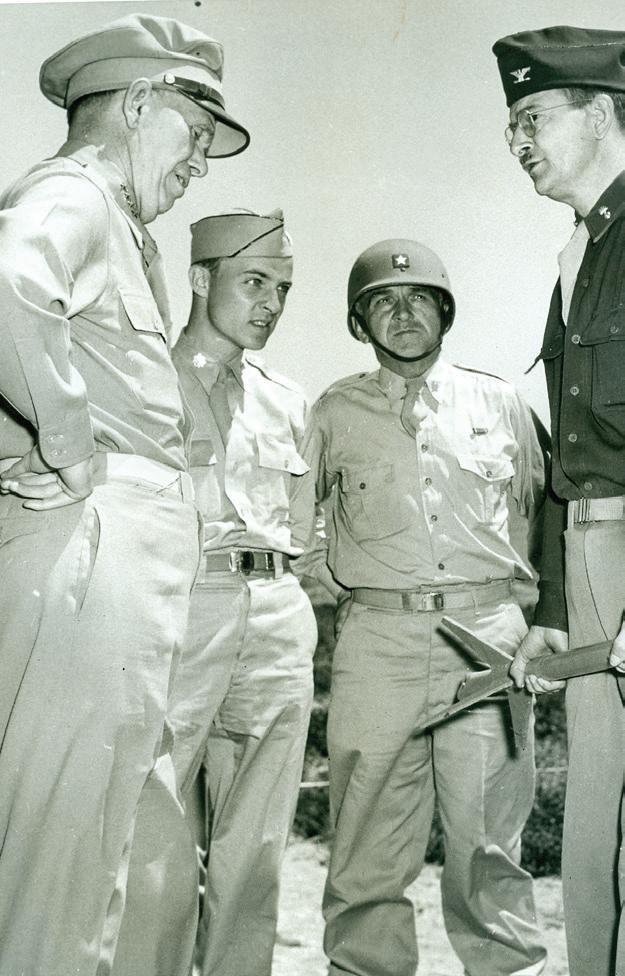
and McCarthy “McCartney” until one day his secretary let him have it and said, “my name is Nason, and McCartney is McCarthy.” Frank McCarthy accompanied General Marshall when he traveled to the great conferences of World War II, including Casablanca, Tehran, and Yalta. Marshall never kept an aide, but McCarthy filled in when needed. In 1944, he was promoted to colonel and became the secretary of the General Staff. This position usually led to a general’s rank and had, in the past, been reserved for regular army officers. He was a reserve officer, so Marshall obviously thought well of him.
Marshall believed that to attain higher rank one had to be married and often would introduce McCarthy to eligible women. McCarthy escorted a number of young ladies, including Mary Churchill, Winston Churchill’s daughter. His nephew, also named Frank, said that Mary was a little wild and the prime minister told his uncle to have her home by eleven. That did not happen, but before Churchill could chew him out for his late return, McCarthy said “It wasn’t me.” In spite of General Marshall’s matchmaking efforts, McCarthy would never marry.
Along with his many wartime duties, while working for Marshall, McCarthy used his con-
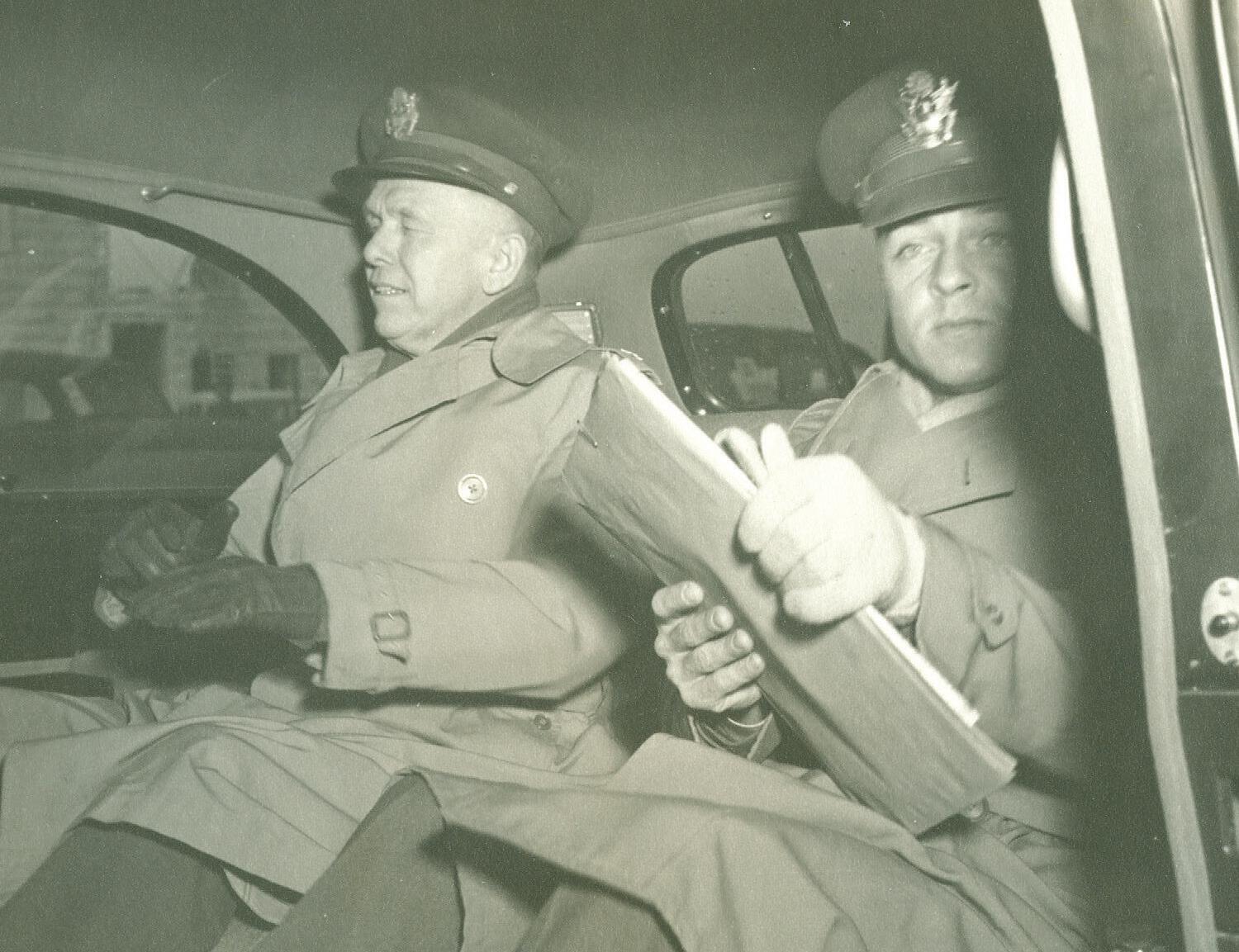
7
Left: Gen. Marshall, Lt. Col. McCarthy, and Gen. John W. O’Daniel listen intently to Col. Thomas Nixon in 1943.
Right: Marshall and McCarthy at the Malta Conference in January 1945
tacts to help those around him. His close friend from their Brother Rat movie days was the actor Eddie Albert, who experienced difficulty adopting a child from an Eastern European country. The process was stuck in the State Department, so McCarthy walked through the request and the adoption became a reality.
As the war neared a close, Frank McCarthy drew more significant attention and was named one of the Outstanding Young Men in America by the U.S. Junior Chamber of Commerce. Henry Ford II was also on this list. His story even appeared in comic book form, and VMI approached him about being considered as the next superintendent. McCarthy declined this honor because he learned from Marshall that you must clean house when you take over an organization and remove the deadwood. This would mean firing some of his friends, and he was not up to the task. This is remarkable as Frank McCarthy was only thirty-three years old, but his wartime ex-
ploits at Marshall’s right hand had made him a media sensation.
McCarthy left the secretariat, and with Marshall’s help became the youngest assistant secretary of state in U.S. history in the Truman Administration. Before he left the SGS, Marshall awarded Colonel McCarthy a Distinguished Service Medal for his contributions during World War II. This was the highest non-combat award given during the war. McCarthy would continue to serve in the U.S. Army Reserves, achieving the rank of brigadier general in 1957. Sadly, his assignment to the State Department was short lived, and McCarthy resigned after six weeks due to “health reasons.”
There is more to that story. From my research, I believe that J. Edgar Hoover, the powerful FBI director, or someone close to him, presented Frank McCarthy with a dossier that prompted him to choose a new career path. This tactic was regrettably common in that period. He had no

8
McCarthy at Dodona Manor in Leesburg, Virginia, with George and Katherine Marshall, 1956.
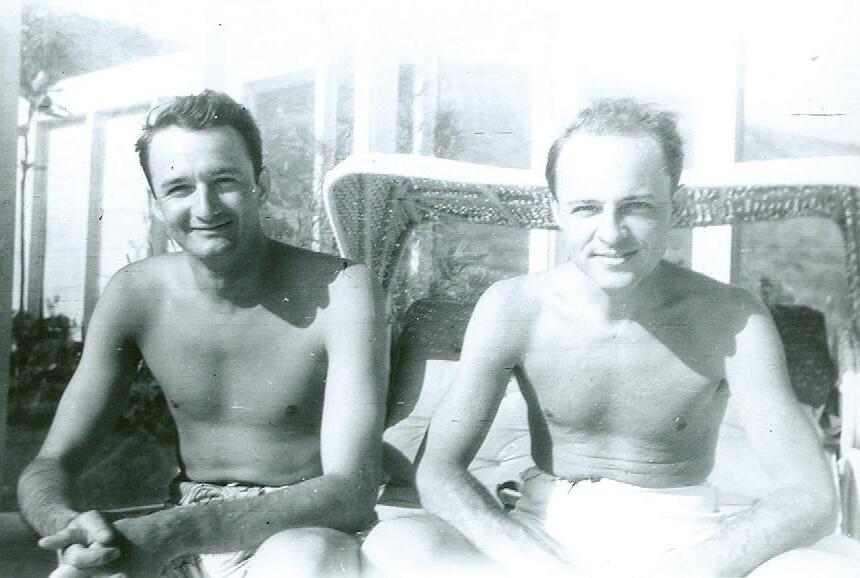
signs of previous ill health, and George Marshall had gone to some trouble to help McCarthy land this job.
Sometime late in the war, McCarthy became involved with a man who became his partner for life, Rupert Allan. Allan was a combat naval veteran who had participated in landings at Guadalcanal in the Pacific and at Utah Beach during the Normandy campaign. He met McCarthy while working in the Navy Department in Washington. He was a Rhodes Scholar and went on to be a famous publicist to many Hollywood stars. Back in the mid-1940s, the two men were inseparable. McCarthy kept his secret from Marshall, which adds a little humor when you think about how he prodded him to get married. Marshall’s wife Katherine had been in the theater and likely knew McCarthy’s secret. At some point, she probably told General Marshall, but no one knows for sure. We now understand that Frank McCarthy was gay.
After leaving the State Department, McCar-
thy and Allan moved to Hollywood. The former would serve as an assistant to the president of the Motion Picture Association and as the MPA’s representative in Europe. In 1949, McCarthy became an executive and producer at 20th Century Fox Studios. He also became head of public relations for the studio, whose duties included being the morals watchdog.
Through the 1950s, Frank McCarthy and the Marshalls retained a close friendship. He visited General and Mrs. Marshall on a number of occasions at their home in Leesburg, Virginia, and at their cottage in Pinehurst, North Carolina. They wrote often, and copies of these letters are in the Marshall Library. Beginning in 1950, while Marshall was secretary of defense, the Wisconsin Senator Joe McCarthy (no relation to Frank) publicly accused Marshall of being part of a communist conspiracy against the United States. Offended by these spurious attacks on his mentor, Frank McCarthy sent a couple of telegrams to Eisenhower urging him to stand up for General Mar-
9
Frank McCarthy (right) with his partner, Rupert Allan (left)
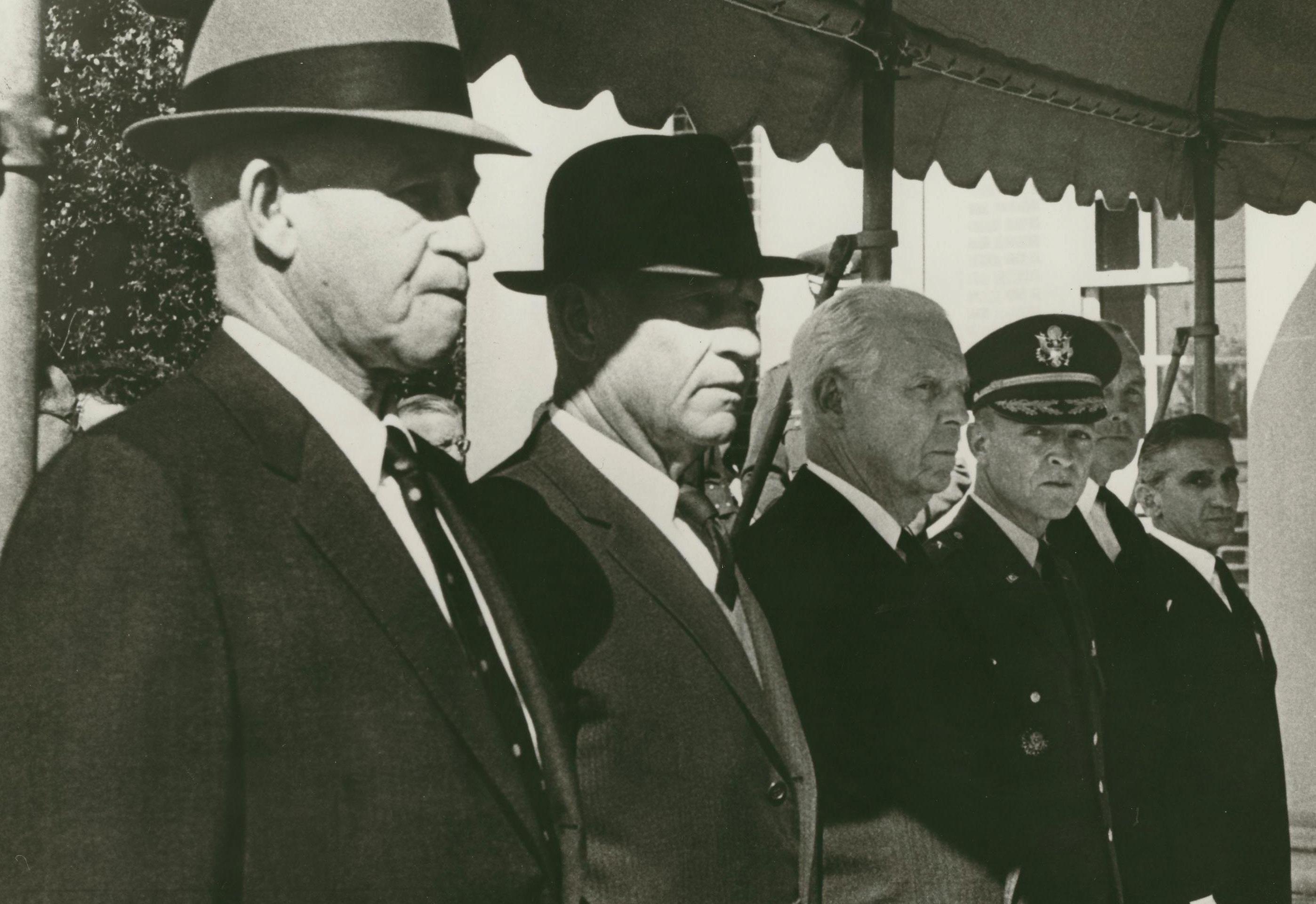
shall. Perhaps in part prompted by McCarthy’s entreaties, Eisenhower worked quietly to counter the senator’s pernicious influences. Ultimately, this work behind the scenes attracted enough support to have McCarthy censured by his Senate colleagues in late 1954.
Sadly, Eisenhower never publicly rebuked Senator McCarthy’s charges against his onetime boss during the remaining years of Marshall’s life. In 1959, George C. Marshall died, and Frank McCarthy was one of his pallbearers. Frank remained close to President Eisenhower and was invited to both his inaugurations. He was a staunch conservative and served as Eisenhower’s campaign manager in California.
Frank McCarthy would go on to produce a number of films, including Decision Before Dawn, Sailor of the King, Guide for the Married Man, and Fireball Forward. Starting in 1951, he decided to make a movie about General George S. Patton, Jr. This production is a story in itself as Frank spent years trying to convince the Patton family
and the Defense Department to make the movie. By the early 1960s, the family was on board with the project, but McCarthy was forced to fight with other studios who tried to beat him to the punch and make their own movie about Patton. He was a tough guy when he had to be and used legal means to block these efforts. He still needed a script, director, and a star, however. Many actors turned down the chance to play the title role. The Patton family wanted Spencer Tracy, but he died before production began. Burt Lancaster was a prime target, but he begged off as did John Wayne, Robert Mitchum, Lee Marvin, and Rod Steiger, who later said it was the biggest mistake of his career. Ultimately, George C. Scott signed on to the project. McCarthy sorted out the script and director as well, lining up promising young screenwriter Francis Ford Coppola and veteran Franklin J. Schaffner, respectively.
Patton took twenty years of McCarthy’s labor before everything came together in 1970. The film was made in Spain because of the availabili-
10
Pallbearers at Marshall’s funeral; McCarthy is at center-right, staring into the camera.
ty of World War II equipment and the location’s cheap production costs. General of the Army Omar Bradley served as technical advisor, and his memoir A Soldier’s Story was the basis for much of the screenplay. The rest is history as Patton won seven Academy Awards including Best Picture for producer Frank McCarthy and Best Actor for George C. Scott, who was magnificent in the title role. Important to McCarthy, the Patton family was pleased. Surprisingly, he did not receive either a percentage or residuals for Patton, which was extremely successful at the box office. Frank would go on to make another military biopic, MacArthur, with Gregory Peck in 1977, though it was not nearly as successful as Patton.
Frank McCarthy remained devoted to his family but living on the opposite side of the country meant he saw them infreequently. He purchased a home for his mother in Richmond and was close to his two brothers. The three would always sing when they got together and produced wonderful harmonies. His nephews remember him as
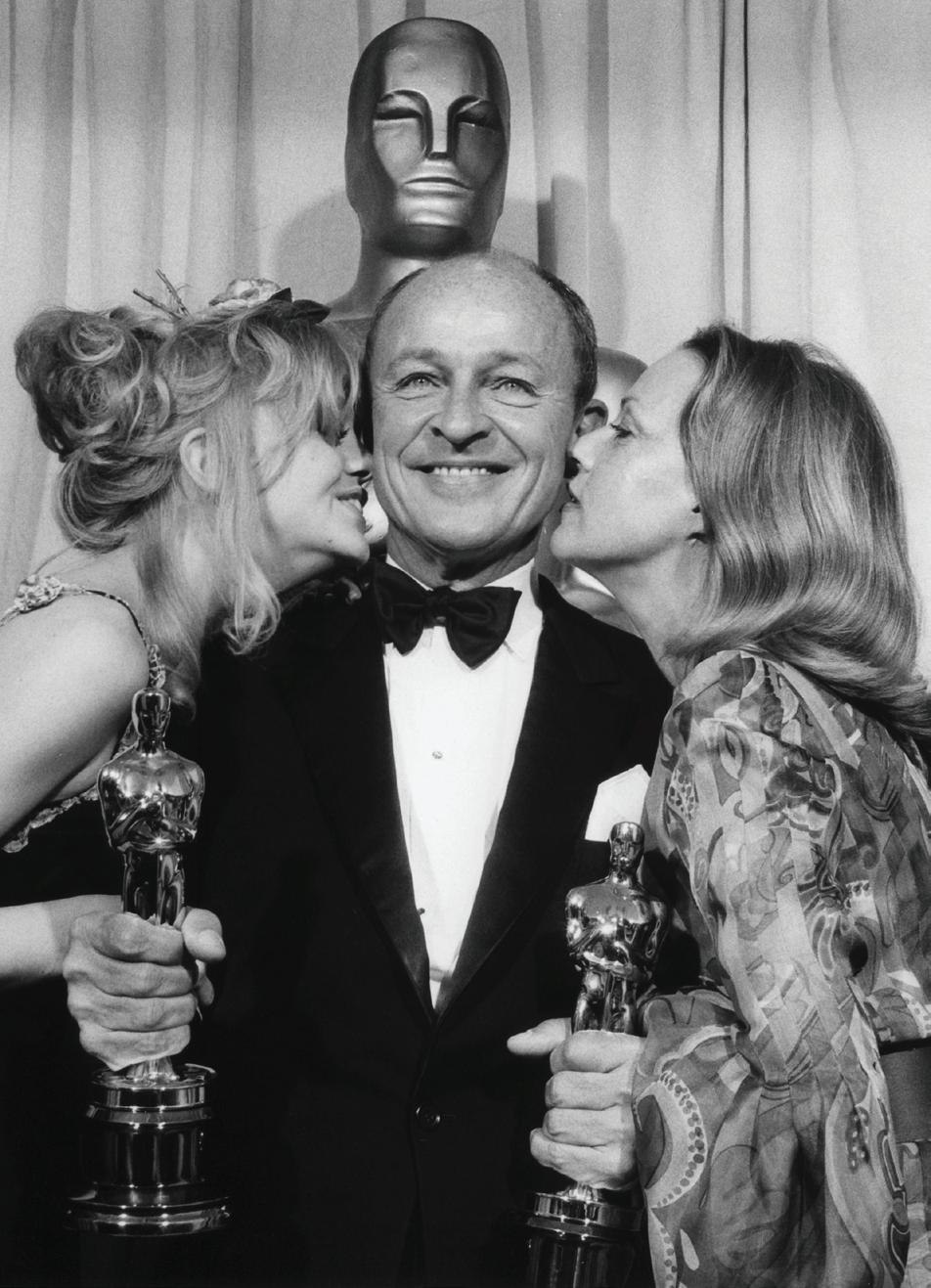
“proper” not stern and as an “intellectual.” They were proud of their movie mogul uncle who took the time to write them letters. During the Vietnam War, Frank returned to active duty briefly and visited bases throughout Southeast Asia. He reported his findings to senior army officials. He was conflicted about the war, seeing progress in the field but privately doubting the wisdom of U.S. involvement.
Frank McCarthy’s career began to wane by 1980. Interestingly, he worked on a movie about Marshall—the Marshall Library has a copy of the script. Although he revered Marshall’s memory, McCarthy thought the treatment lacked the pizazz needed to make it a success—Marshall was certainly not a colorful figure like Patton. McCarthy returned to VMI to help dedicate the Marshall statue in 1981. His Oscar went to the Marshall Foundation, where it remains to this day.
Frank McCarthy was a very private man who wanted to be remembered for his work during World War II and his Hollywood successes. He

11
Left: McCarthy, with Goldie Hawn and Jeanne Moreau, holding Academy Awards for Best Actor and Best Picture. (Alamy photo)
Right: McCarthy’s Academy Award for Best Picture in the Marshall Foundation library.

was a great public speaker with a Virginia accent who carried himself like the general he was. Through most of his postwar life he and his longterm partner, Rupert Allan, entertained a bevy of Hollywood royalty, including Grace Kelly, Cary Grant, and Jimmy Stewart. Frank and Rupert were especially close to Kelly, the former actress and princess. They visited Monaco so often that they had a room at their disposal at the palace in Monte Carlo.
Frank never relinquished his association with VMI and attended a last reunion in Southern California prior to his death in 1986. As he lay on his deathbed with cancer, Frank’s brothers, Julien and Bill, came for a final visit. The brothers harmonized together one last time, though Frank’s voice was weak. He died on December 1. Frank McCarthy’s close friend, the actor Eddie Albert, gave the eulogy, and the Hollywood elite attended. Afterward, his ashes were spread at sea off the coast of California, and a stone with his name was placed near his family in Hollywood Cemetery in Richmond.
Bill Scherer, a VMI graduate, works in the movie industry and knew Frank McCarthy well. He describes him as “admired and loved” by people in
front of and behind the camera. McCarthy was a great storyteller, said Scherer, and was without an ego. He kept confidences and as a result was close to the Hollywood elite. He was so “well rounded” that he could talk about any subject. Finally, Scherer remembered that McCarthy rarely talked about himself, and instead wanted to know about those around him. Bill Scherer proclaims that he will never forget Frank McCarthy. What a great memory of a remarkable man—the general and the Oscar-winning producer who lived two lives in two different worlds.
Lt. Col. (Ret.) James Dittrich graduated from VMI in 1976 with a degree in history. He has a degree in international relations from Boston University and is a graduate of the Army Command & General Staff College. Lt. Col. Dittrich spent twenty-two years in the U.S. Army with more than ten years overseas. He was selected for promotion to colonel before he retired. Currently, he is the Alumni Association Historian for VMI and has written extensively about VMI history. He lives near Perryville, Arkansas and is married with three adult children.
12
Color portrait of Frank McCarthy, undated
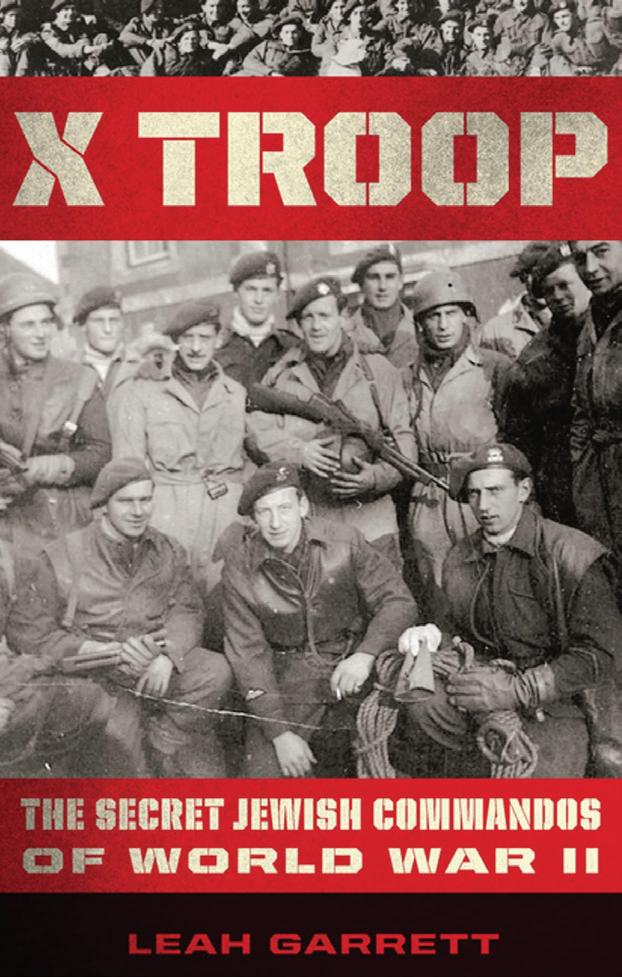
Dr. Garrett will present a virtual Legacy Lecture on the Marshall Foundation website and YouTube channel on February 23, 2023.
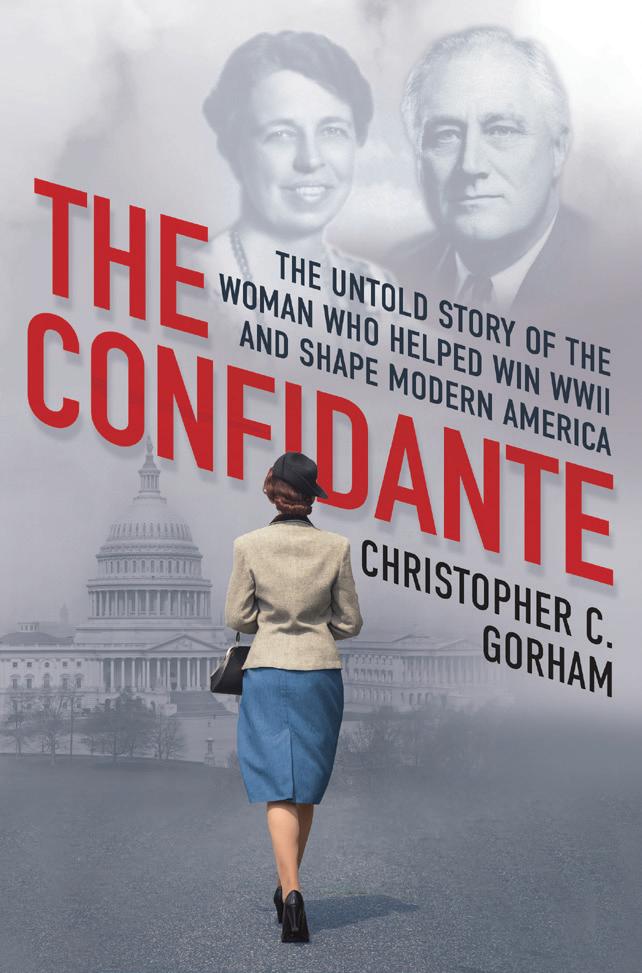
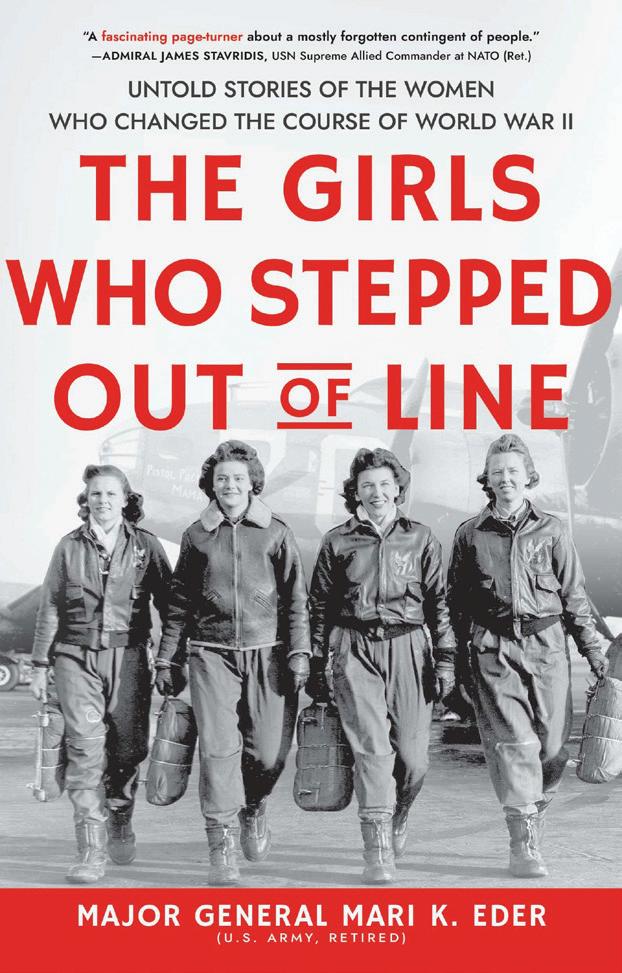
Maj. Gen. Eder will present a Legacy Lecture on her book on March 9, 2023, at the Marshall Foundation in Lexington, Virginia, and livestreamed on its YouTube channel.

Mr. Gorham will present a Legacy Lecture on his book, about assistant secretary of defense Anna Rosenberg, on April 20, 2022, at the Marshall Foundation in Lexington, Virginia, and livestreamed on its YouTube channel.
All of the Marshall Foundation’s public lectures, including Dr. Mark Groeteleuschen’s talk on the St-Mihiel offensive of World War I and Marshall’s early career, are available on our website and www.youtube.com/c/GCMarshallFoundation
13 NEW BOOKS AND UPCOMING LECTURES

AN “ARMY ON THE ALERT” THE CREATION OF THE COLD WAR ARMY IN GERMANY, 1945–1955
by Ashley Vance
In 1954, The Big PicTure, the army’s weekly television show, explained to potential draftees that “we are trying to mobilize in peacetime for any eventuality.” A year after the Korean War ended, the army still needed soldiers. Throughout the 1950s, U.S. Army, Europe (USAREUR), firmly entrenched in the center of Cold War political tensions, maintained a force of more than 230,000 soldiers to deter a Soviet invasion of West Germany. Preparing for a war that would ultimately never come, the army presence in Europe was predicated on its ability to maintain combat readiness in case of an emergency. Commonly known as the “Cold War Army,” this ground force spent most of its time preparing for that mission.
However, the U.S. presence in postwar Germa-
ny was not always a large deterrent force. Following World War II, the army managed an unprecedented military occupation while it conducted the largest demobilization program it had ever undertaken. Demobilization devastated the units that stayed behind in occupied Germany. In the first two years of the occupation, the number of troops shrank from nearly three million to a mere 90,000 soldiers. Shrinking numbers also meant a loss in combat readiness. Simply put, the army in Europe was no longer a capable fighting force. Yet, by mid-1951, a quarter of a million U.S. soldiers in West Germany spent much of their time conducting training exercises and field maneuvers.
So how did the army transform from an ineffective occupation force to a large, combat ready
Opposite: Pfc. Hilton
L. Keene is surrounded by a group of German children as he prepares to leave Weimar, July 1945.
15
THE PEACETIME ARMY
Cold War Army? The core of this change took place in 1947 when European Command (EUCOM) reorganized occupation forces for combat. More than a year before the Berlin Airlift, the army began to build a force for the Cold War when it accepted its role as the military arm of the developing political contest between East and West. By the time Seventh Army reactivated for the Korean War in 1950, an army built for the Cold War was already in place in occupied Germany. The arrival of 180,000 troops in 1951 cemented the transformation of the World War II Army into a Cold War Army.
At the end of World War II, the army’s top priority was the demobilization of almost three million soldiers. At the same time, it began the military occupation of defeated Germany. Military Governor General Lucius Clay remarked that “Nobody had had any experience in this kind of job . . . In Germany we had no background, because after World War I, there was always a German government; occupying troops were there
for military purposes . . . We had nothing. We had to improvise, we had to make decisions on the spot.” Indeed, improvisation to meet new needs would come to define the occupation.
The first major initiative to combat the personnel issues caused by demobilization transformed the very nature of the occupation. The army’s original occupation concept was to have what Earl Ziemke called an “Army Type Occupation,” with a large soldier presence and a strategic reserve. Given the manpower problems, Army Chief of Staff General George C. Marshall suggested to General Dwight Eisenhower the use of a “Police Type Occupation,” based on the premise used in Japan. Eisenhower agreed but rejected the part of the model that employed local police. Instead, an army police force would provide all security and order throughout the Occupation Zone. The new U.S. Zone Constabulary police occupation would be led by a corps-sized mobile unit that would be supported by a smaller, tactical reserve. Stars & Stripes noted that the “bold Scout cars of the U. S. Army’s 12th Armored Division pass in review at a parade in Swabisch, Germany, July 1945.

16

experiment” represented “a departure into a new military field of operations for the Army” and was “about the only alternative, for a larger army has been a continuous headache of dubious morale, slack discipline, and untrained men.”
Although the plan was for the constabulary to have a tactical reserve, that plan did not come to fruition. By the time the unit became fully operational in mid-1946, it was only supported by the 1st Infantry Division, the remaining combat unit in occupied Germany. Scattered throughout the U.S. Zone, the two units maintained security, both within the Zone and along its 1,400 miles of semi-international and internal boundaries. The biggest consequence of transforming the occupation from an “Army Type” to a “Police Type” occupation was the collapse in combat readiness.
Even though the Zone itself was secure, units in Germany were no longer capable of defending themselves or their Allied neighbors from an external attack. While not an immediate threat, the rising tensions with the Soviet Union made
the issue an ever-present concern. To cope with this problem, army commanders in Germany improvised and experimented new policies into existence. First among them was the process to involve the German police in zonal security. The constabulary partnered with German police forces, allowing them to slowly take on duties, such as border patrols, being conducted by the army police. This gave the Americans the flexibility to accomplish close to the same security goals with a fraction of the manpower. This smaller force met the War Department, President Truman, and the American public’s demands for a smaller military in the postwar period. In essence, the constabulary gave the army the flexibility it needed to grapple with larger security problems.
By the end of 1946 it was clear that a Nazi resurgence was not going to materialize. But the external Soviet threat was growing, and planners needed to respond. A report at the time noted that “the realization served to justify, in the minds of planners, a more equitable distribution
17
Members of the 3rd Constabulary Regiment stationed in Wetzlar, Germany, June, 1946
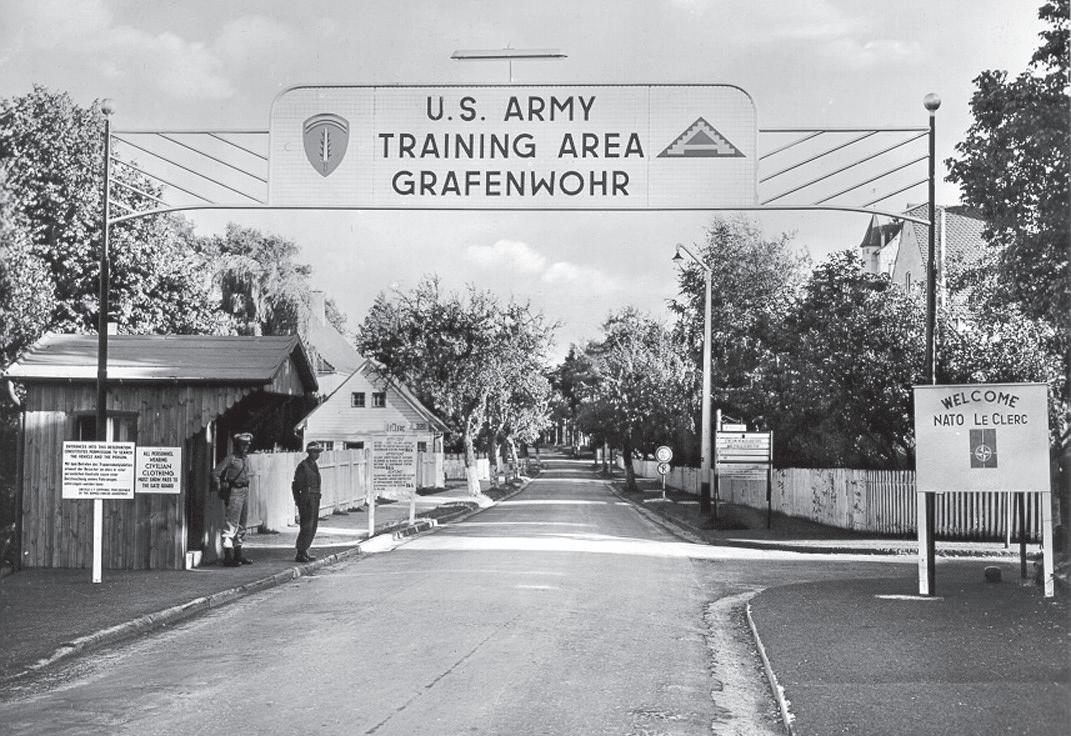
of manpower between Occupational duties and a combat reserve.” This new approach was both a proactive effort to be prepared for a Soviet invasion and a reaction to the disintegration of unit effectiveness.
The army of World War II no longer existed. At the beginning of 1947 there had been almost no tactical training in Germany for more than eight months. Therefore, a major initiative would have to take place to reorient the occupation for combat. After months of planning, a theater-wide reorganization got underway in February 1947. The constabulary and 1st Infantry Division units were reorganized to have a combat focus, instead of a focus on policing and border security. Interestingly, planners began the overhaul without requesting more troops while demobilization, poorly trained incoming recruits, and high turnover continued.
The year-long reorganization to rebuild combat readiness marked the fundamental punisher-to-protector shift in the occupation. Too of-
ten, scholars put this transition at the beginning of the Berlin Airlift in 1948 or at the formation of the Federal Republic of Germany in 1949. However, the new combat focus had been underway for more than a year before the Berlin crisis began. The reorganizations that took shape in spring 1947 were specifically aimed to rebuild a combat reserve for the defense of Germany. For the army in Germany, the “punisher” phase saw the decimation of troop levels, decrease in combat readiness, and a principal switch to a newly conceptualized “Police Type Occupation.” The “protector” phase began with an understrength, unprepared occupation force that consisted of just one scattered division and a mobile corpssized police force. U.S. Forces, European Theater (USFET) needed forces in Germany to return to their former capabilities, but it had to rebuild on a shoestring budget. Therefore, steps were taken at all levels of command from Washington to Heidelberg to solve the occupation’s problems and face the developing Cold War.
18
Gate at Grafenwöhr, undated
The opening of the training camp at Grafenwöhr in spring 1947 marked the beginning of European Command’s public commitment to establish a combat reserve and initiated the formation of what would become the Cold War Army in Germany. Before 1947 training focused on border security, lightning raids, and individual readiness to compensate for poor soldier quality in the replacement system. After 1947, training was for combat. General Clarence R. Huebner and commanders at EUCOM, with a preference to use infantry units for defense, predicted that the “Constabulary unit would be deactivated over the next three years as the German government assumed responsibility for internal security.” If the transition was completed as planned, the constabulary would no longer be a full-time job. Many considered this slow elimination of the constabulary a reflection of the unit working itself out of a job. If fully successful, German police would be capable of handling all zonal security. The benefit of the handoff was the freeing up of
soldiers to train at Grafenwöhr as an alternative to requesting more soldiers.
The defining feature of the Cold War Army was the training it conducted for its defensive mission. Unlike their counterparts in occupied Japan, the soldiers of the postwar German occupation spent most of their time training for combat. The peacetime mission afforded the men the ability to do so. It was generally understood, and proven by the Korean War, that the next conflict would come without prior notice. Troops in Europe, therefore, needed to maintain a state of readiness not previously held by American peacetime forces. Also unlike other deployments, the maneuvers were highly visible and closely connected to the local population. Exercises in Germany took place off base and were intermixed throughout cities and villages. Training centers and schools were often set up adjacent to towns for close access to infrastructure, and field maneuvers traversed farmlands and villages. In an area as small as the U.S. Zone of Occupation in Germany, it

Members of the 7th Field Artillery Battalion await fire orders during Operation Snowdrop, the U.S. Army’s first winter maneuvers in occupied Germany, January 20, 1947.
19
was virtually impossible to separate the thousands of American soldiers from the sprawling German population.
After spending two years transforming units to have a combat focus, EUCOM officially recognized the defensive mission in Germany in 1950. This recognition was a culmination of the increased Cold War tensions, the growing Soviet military threat, and the Korean War. But the small occupation force was not capable of actually defending West Germany. General Matthew Ridgway once remarked that, “The greatest weakness in this potentially powerful force [in Europe] lies in the vast front that it must cover, and in the disparity of the number of men under arms as compared with the strength of the Russian forces . . . The first thing we had to do . . . was to set up the vast and complex logistical structure which would support the forces we had if they should be committed to battle.” That logistical structure included getting more forces to Germany and building the infrastructure to house and train
them.
The troop augmentation to Germany that followed the beginning of the Korean War was nothing short of miraculous. The number of troops in West Germany in summer 1950 was approximately 80,000. Less than a year later, that number ballooned to more than 250,000 soldiers. At the beginning of 1952, General Thomas T. Handy reflected on the troop mobilization thus far and remarked that, “Everything has not gone absolutely smoothly but the surprising thing is that we have been able to do it as well as we have. We have gotten them housed and we have gotten training facilities, etc . . . I do not think we realize sometimes what a big job some of our people have accomplished.” The troop expansion was a massive undertaking for the Cold War Army. EUCOM and USAREUR faced an unprecedented challenge to expand a peacetime occupation mission in a semi-sovereign nation— and commanders learned how to do so in real time. Developments in the occupation, including Pfc. Jesse F.
Heath removes the sign of the 3811st Quartermaster Truck Company, prior to U.S. occupation being replaced by the Soviet army, Weimar, Germany, July 4, 1945.

20
preparing for and accepting the soldiers, expanding the infrastructure to support them, conducting racial integration, and adjusting to the rise of dependents, all happened within the context of that real-time growth. In many cases, leaders improvised as they learned how to expand, adjusting plans and policies to meet the demands and challenges that arose in the process.
The infrastructure built for the incoming troops, including the rehabilitation of existing German barracks, kasernes, and the construction of new housing, was completed with an expectation that American forces would one day leave and turn the properties over to the West Germans. Even after the commitment to increase the forces in Europe was made in fall 1950, the presence of American forces continued to be viewed as a temporary venture. German military historian Bruno Thoß noted that leaders thought the troop augmentation would “only be a temporary measure until European rearmament had reached the point that the Europeans were capable of regional self-defense.” Indeed, even the negotiations for the addition of troops to Europe were provisional because of the new semi-sovereign status of the Federal Republic. The assumption, on all sides, was that U.S. forces would leave after the occupation ended and the West German government was allowed to rearm. However, in the process of expanding to include an additional four divisions, the Cold War Army created a sense of permanence in West Germany.
The arrival of troops was just the first step in a broader initiative to secure Western Europe; a mission that ultimately continued for another forty years. As General Eisenhower reported to NATO in April 1952, “There is no real security yet achieved in Europe; there is only a beginning.” Politically, the question of German rearmament needed to be answered. The conclusion of the Bonn Convention negotiations in early 1952 theoretically dealt with that issue, although it would not be solved until 1954. Militarily, U.S. forces needed to prepare for the worst-case scenario. The expansion of field maneuvers in the early 1950s allowed EUCOM and its NATO al-
lies to work through invasion scenarios and, later, to test the effectiveness of using atomic weapons in a war against the Soviets.
The American occupation of Germany ended on May 5, 1955. The event was widely publicized and heralded as a political victory. The New York Times celebrated the success when it said the United States “fashioned the new state out of the debris of the Nazi military collapse in 1945 and then acted as godfather, endowing the infant with worldly goods and guiding its first footsteps in the new world.” However, for all of the publicity, very little changed on the ground. Stars & Stripes explained that “For the man in the street, there will be little immediate impact from the changed status.” This was in part because the “occupation had been so benign in the last two years that its official ending went virtually unnoticed.” The permanence created when 200,000 soldiers arrived in the early 1950s set the tone for the military presence in Germany for the foreseeable future.
The Big Picture summed up the purpose of Seventh Army in Germany as “army on alert, ready to meet trouble out of the east.” It was “an army devoted to discouraging a fight, but meanwhile, building up a solid punch should it come.” The Cold War Army stood ready to face the Soviet Union if it invaded. It focused its efforts in preparing for that possibility. The transformation of the World War II Army into a Cold War Army provided the foundation for the force that remained in West Germany until the end of the Cold War, and that ultimately remains there today.
Ashley Vance is a PhD candidate at Texas A&M University and is currently completing her dissertation. She also serves as the Department of History’s Career Diversity Fellow, where she advocates for graduate professional development and career opportunities beyond academia.
21
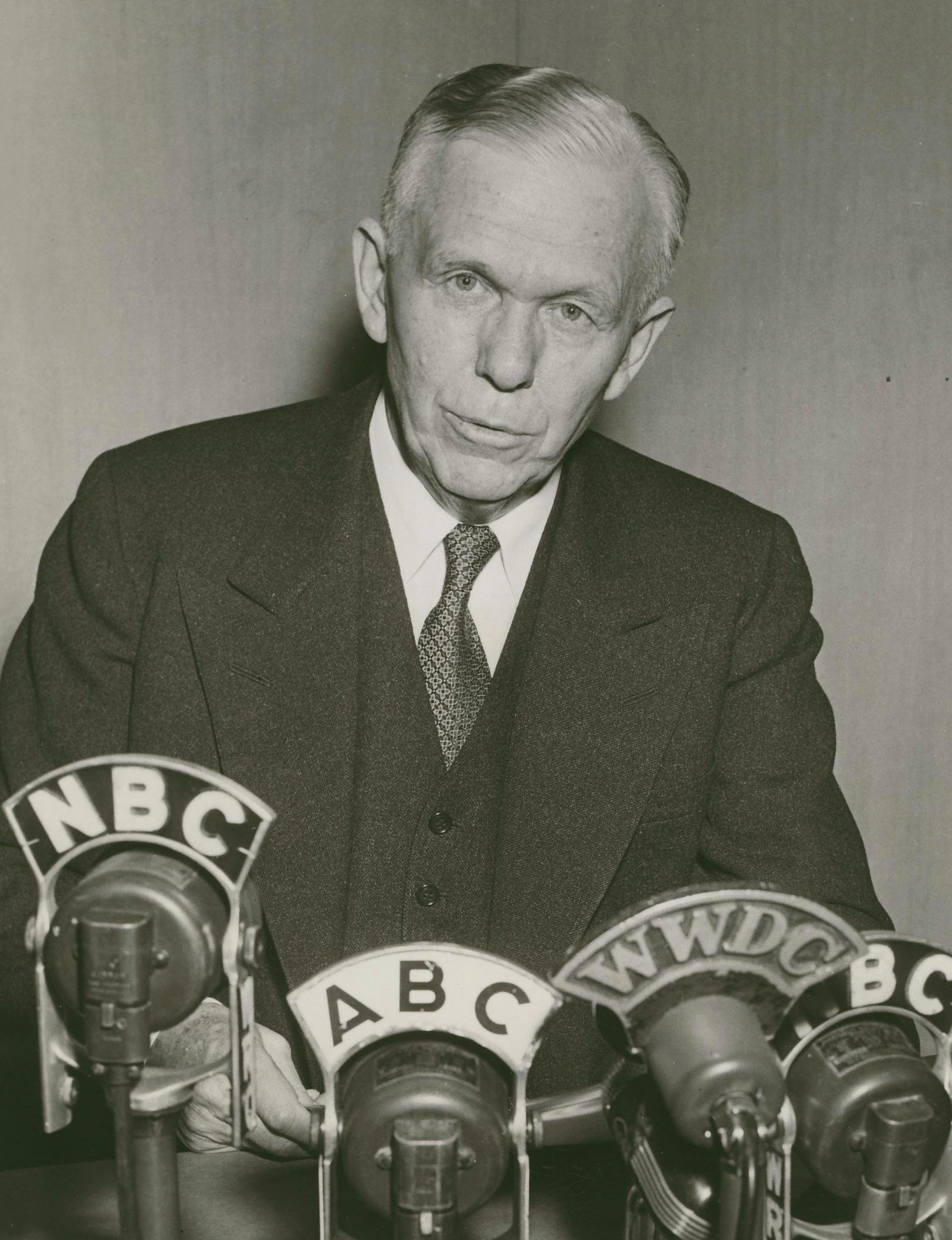
MARSHALL IN THE WORDS OF OTHERS
by Cody Youngblood
George Catlett Marshall has gone down in history for his words. Indeed, his 1947 Marshall Plan speech at Harvard University is still considered one of the most consequential orations ever given. What others have said about Marshall, however, is rarely considered in the annals of his life. Brief yet powerful appraisals (and condemnations) by his contemporaries demonstrate Marshall’s legacy of integrity, duty, and leadership against all odds.
Marshall addresses the American public on radio, following the Moscow Conference, 1947.
23
MARSHALL THE MAN

“Marshall is fully the equal of the best.”
Brig. Gen. Scott Shipp to President
William McKinley, February 14, 1901
Upon Marshall’s arrival to the Virginia Military Institute on September 11, 1897, the young cadet-to-be looked anything but a soldier. At six feet tall, weighing around 130 pounds, still thin from typhoid fever and nursing an injured right arm, Marshall’s introduction to military life was challenging. His first year was by all accounts fraught with difficulties, from bad food to uncomfortable living conditions. The young cadet was even a victim of hazing which left him with a
gashed buttock after being forced to squat over an exposed bayonet. In the eyes of VMI, such experiences shape a cadet’s character. Marshall would later say his first year was “quite an ordeal, though I came afterwards … to look back on it with more appreciation than any other year.”
The seeds of Marshall’s leadership skills were sown in his third year at VMI. He was promoted to first sergeant after standing at the top of the second class officers. Non-commissioned ca-
24
Marshall, VMI Class of 1901 portrait

det officers oversaw keeping the corps in line and well behaved, which was not an easy job. Marshall said the cadets “would judge you very severely if you proved to be a very slack performer in the business of your military grade.” His scores improved by this time as well, and by the end of the year Marshall stood nineteenth in his class of forty-seven.
Luckily for young George Marshall, he was not a slack officer, and the respect shown to him by his fellow cadets earned him the highest rank of the corps his final year: first captain. While sometimes austere and reserved, Marshall’s pragmatic leadership style as first captain did not tolerate misbehaving, and as Marshall said, he ran the mess hall “with hardly a loud laugh.” This caught the attention of VMI Superintendent Scott Shipp who, as a veteran of the Civil War, easily recognized budding commanders. When it came time for Marshall to try for a commission in the U.S. Army, Shipp backed Marshall.
With the help of his father, Marshall collected
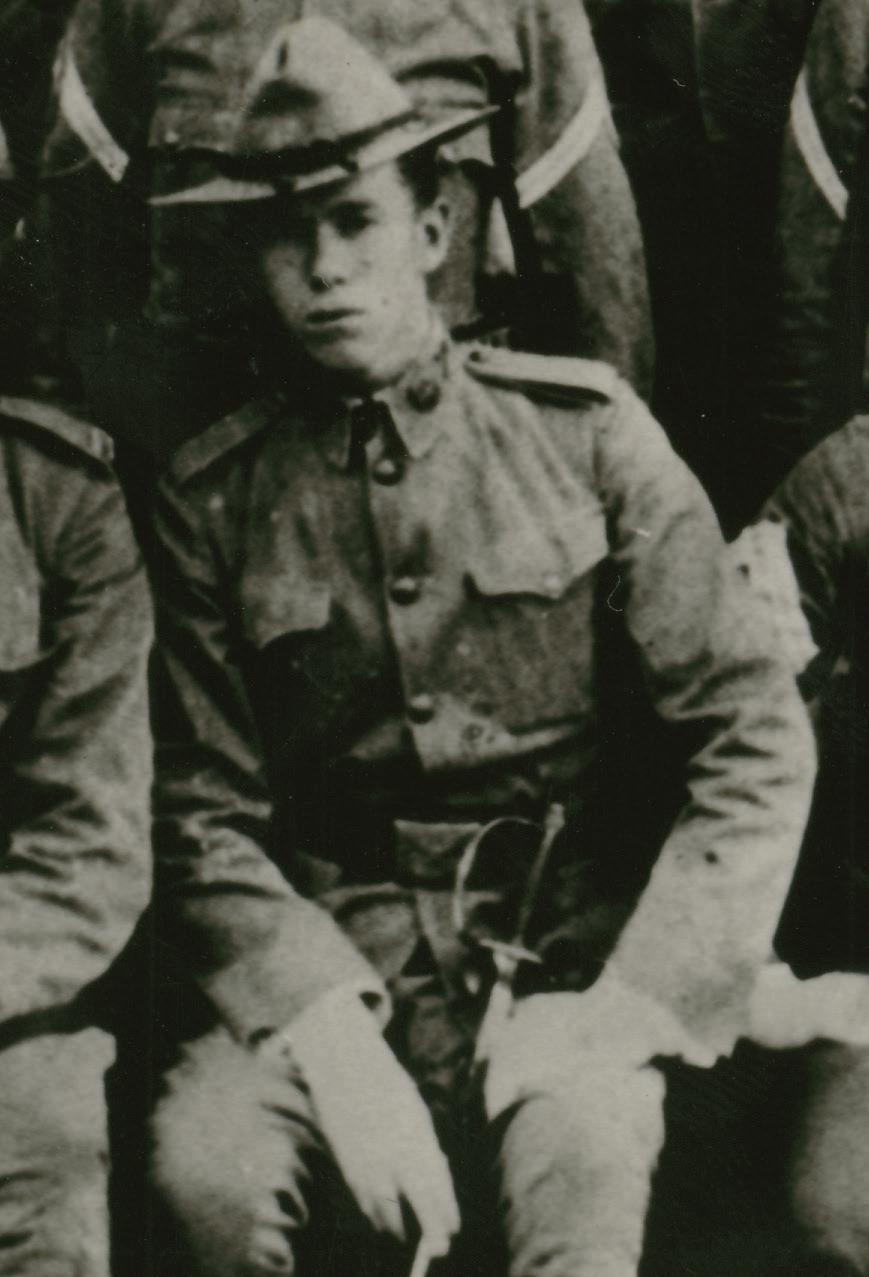
letters of endorsement throughout the year 1901 to better his chances of a commission, which at the time was hard to secure. A new law passed on February 2, 1901, required the appointment of 837 new lieutenants. Priority was given to West Point graduates, next to applicants from the ranks, then to former volunteer officers, and finally to civilians.
General Shipp wrote a general letter on January 23 recommending Marshall for a lieutenancy, saying, “I assert with absolute confidence that if commissioned in the army, young Marshall will in all respects, soon take his stand much above the average West Point graduate.” At the request of Marshall’s father, Shipp wrote a second letter on February 14, this time to President William McKinley, affirming “Marshall is fully the equal of the best.” Cadet Marshall passed his army entrance exam and received his commission after his twenty-first birthday, which was, as Marshall told General Shipp, “A little late, but very acceptable Xmas gift.”
25
Left: Brigadier General Scott Shipp, superintendent of VMI, circa 1905. (Library of Congress photo)
Right: Marshall with the 30th U.S. Infantry, 1901
“Yes, but I would prefer to serve under his command.”
Lieut. Col. Johnson Hagood, Efficiency Report, December 31, 1916
As tensions increased and war broke out in Europe, concerned American citizens, led by former Chief of Staff of the U.S. Army Leonard Wood sought to strengthen the military. Wood organized the Preparedness Movement, encouraging private citizens to join volunteer pre-enlistment training programs nicknamed “Plattsburgh camps.” These privately funded ventures recruited additional potential army officers in the summers of 1915 and 1916. In an unusual career move,
Marshall was assigned to two of these camps. Fourteen years after he had entered the army, Marshall was promoted to captain in July 1916. His first assignment came on behalf of General J. Franklin Bell, who ordered Marshall to a volunteer camp in Monterey, California. Bell wanted his new captain to stiffen training programs at the camp while recognizing the dangers of clamping down too hard. The volunteers were paying to be there, after all. Pulling from experience with Soldiers rest during maneuvers in Monterey, 1916
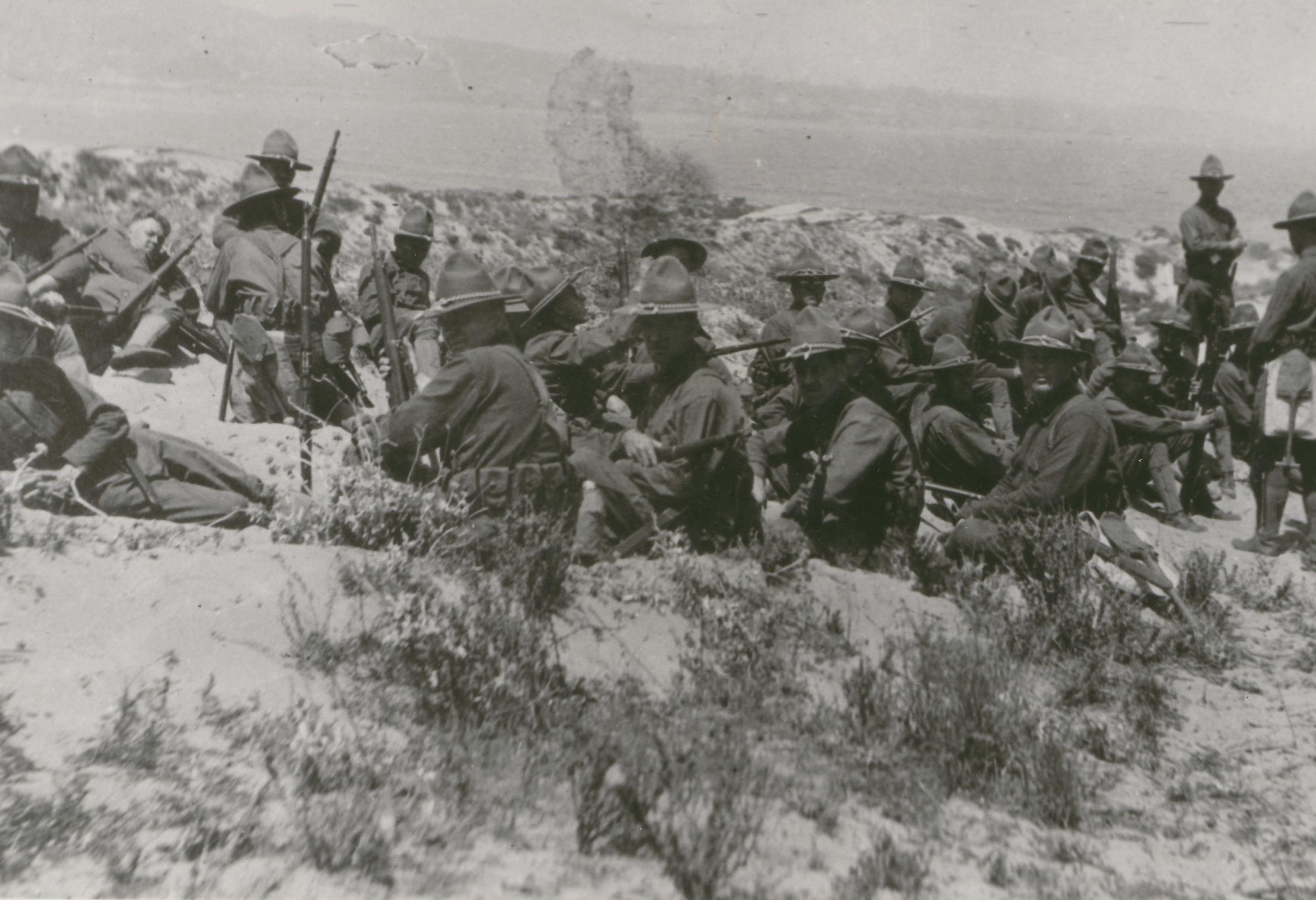
26
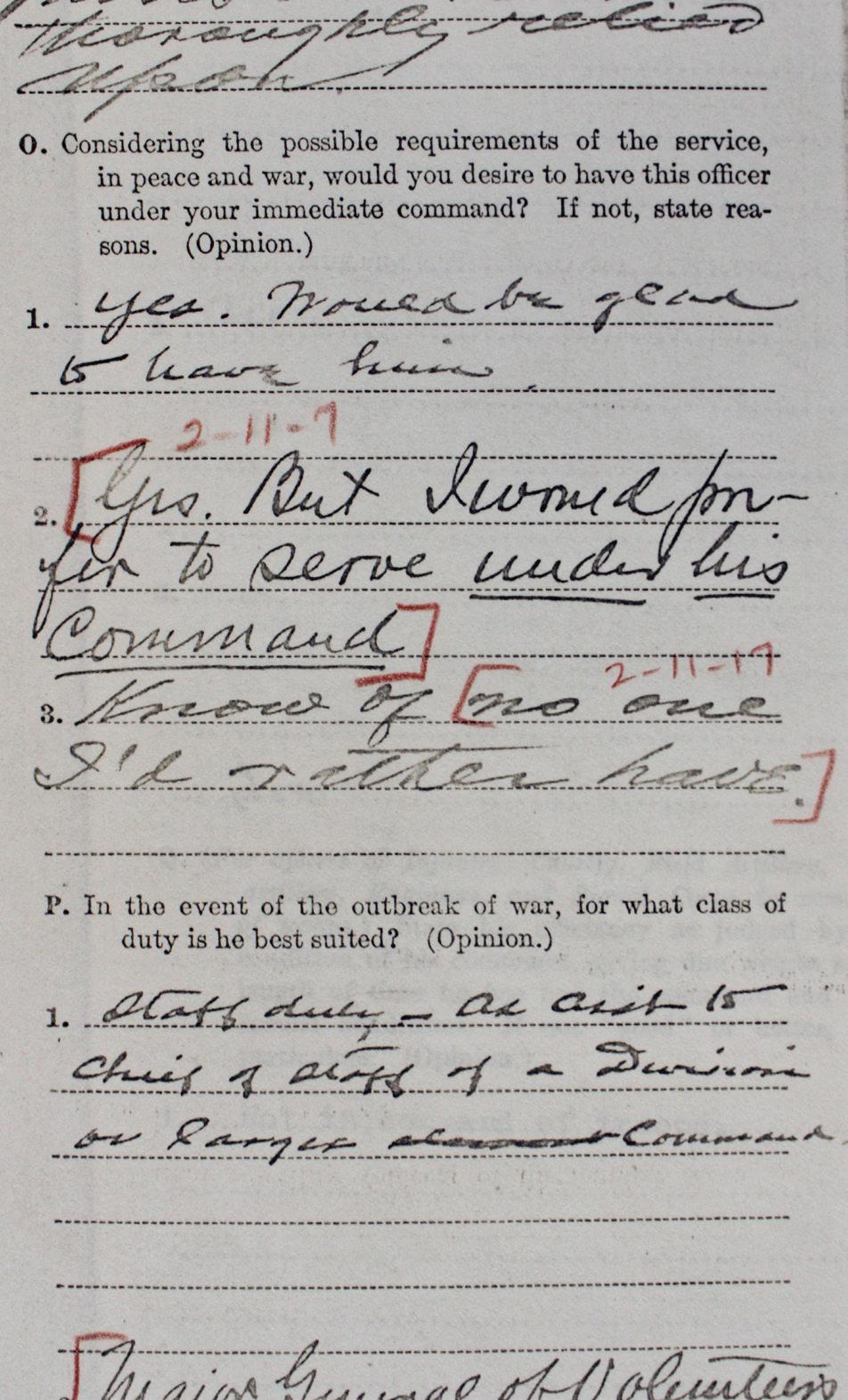
the national guard, Marshall recommended new training maneuvers and tighter regulations to the camp commandant, Brigadier General William L. Sibert.
When the Monterey camp closed, Marshall assisted in establishing a new camp at Fort Douglas near Salt Lake City, Utah, of which he became adjutant under Lieutenant Colonel Johnson Hagood. Marshall’s reputation for excellence as a military organizer had already been recognized by this time and was known throughout the army. His work at Fort Douglas with 1,200 volunteer recruits continued to cement this reputation.
Fort Douglas closed after one month, after which Hagood as commanding officer was required to write an efficiency report on those under his command. When writing about Captain Marshall, Hagood prepared perhaps one of the
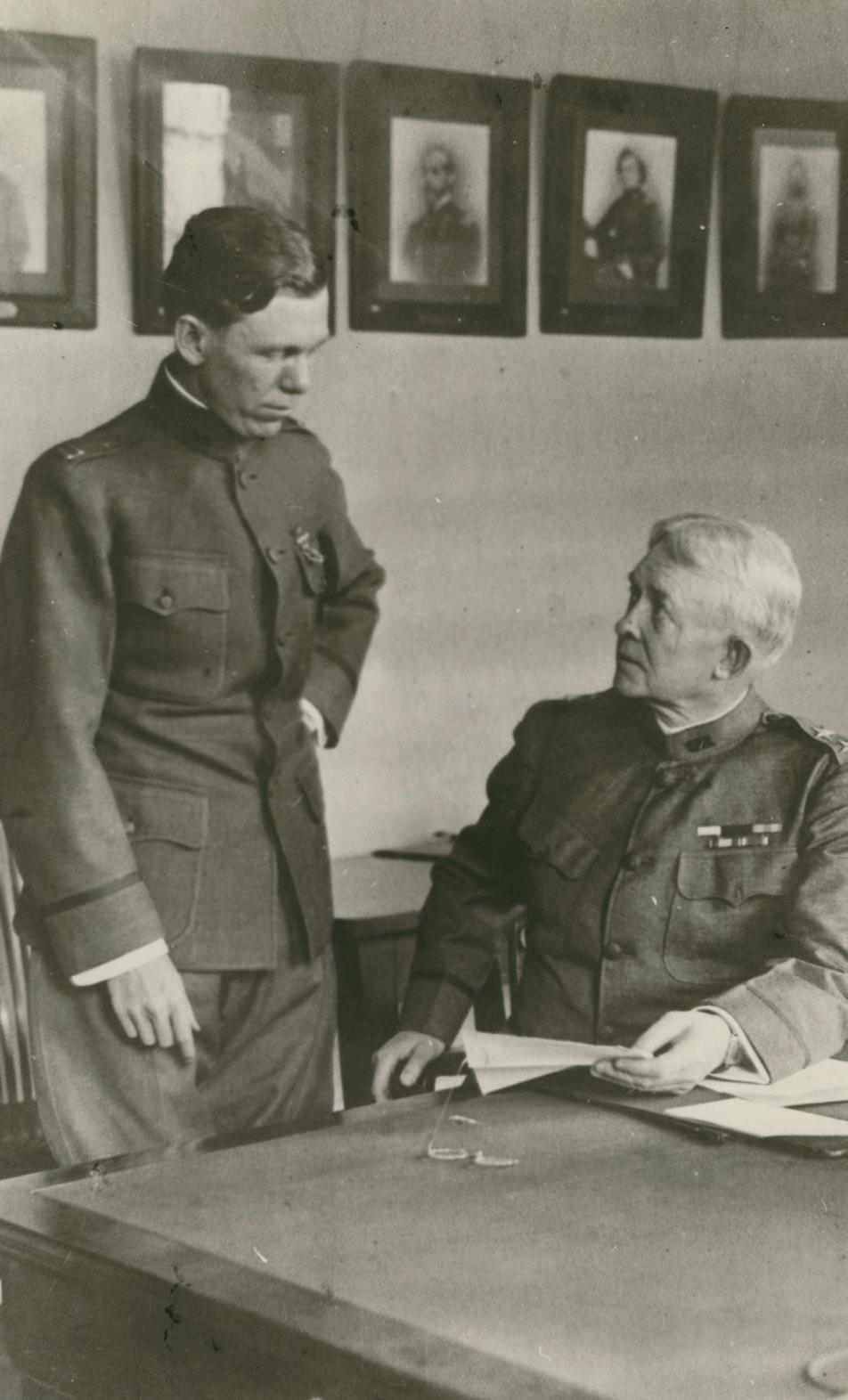
most eloquent and exceptional reports for a subordinate. In response to the question: “Would you desire to have him under your immediate command in peace and in war?” Hagood wrote concerning Marshall: “Yes, but I would prefer to serve under his command…. In my judgment there are not five officers in the Army so well qualified as he to command a division in the field.”
He went on to call Marshall “a military genius” and recommended that he be made “a brigadier general in the regular Army, and every day this is post-poned is a loss to the Army and the nation.”
Regulations be damned, there were over 1,800 officers, including Hagood, who were senior to him. Unfortunately for Hagood, his worthy officer would not receive such a rank for another twenty years.
27
Left: Lt. Col. Hagood’s remarks on Marshall’s efficiency report
Right: Cpt. Marshall and Gen. Bell in 1917 at Governors Island

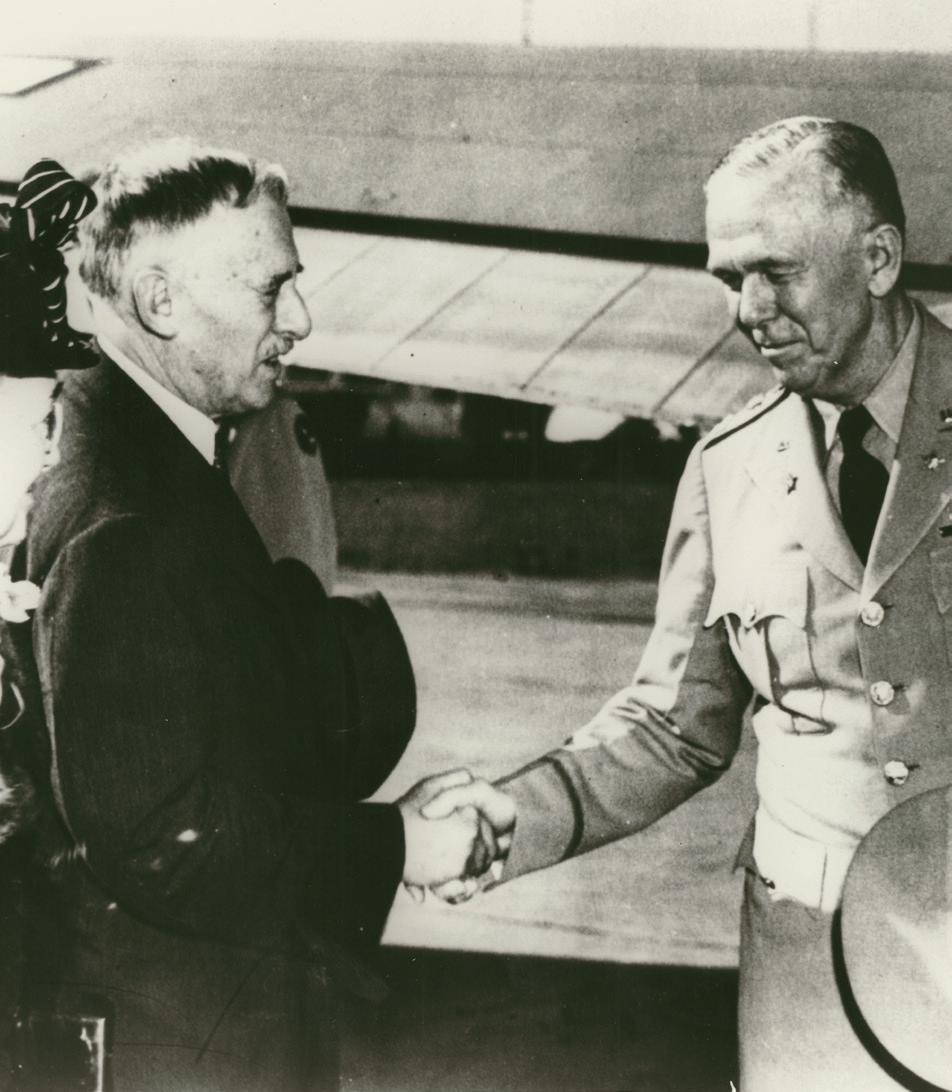
“All have recognized his intellectual power, his selfless integrity, and his inflexible habit of considering only the general interest and never his own.”
Henry
L. Stimson to President Harry S. Truman, September 18, 1945
Seventy-five million people lie dead. Japan and Nazi Germany toil in defeat, and victory has come to the Allies. World War II is over. But amid the fanfare of success, Secretary of War Henry L. Stimson submitted his resignation, three days before his seventy-eighth birthday. His career spanned four decades, and he served under seven presidents, more than any other American citizen of his era.
Stimson informed President Harry S. Truman and his cabinet of his resignation during a meet-
ing on September 18, 1945. At the close of that meeting, Stimson handed a statement to the president praising one person whom he believed was “the outstanding man among the English speaking soldiers of this war, bar none.” To Stimson, George C. Marshall modestly defined the successful strategies which won the war and effectively mobilized the U.S. with a skilled fighting force. Even before the close of the war, Stimson had told Marshall he was “the finest soldier I have ever known.”
28
Left: Gen. Marshall and Henry L. Stimson
Right: Shaking hands at Stimson’s retirement, September, 1945
It is easy to see why Stimson admired Marshall so greatly: their offices connected with a single door, which Stimson said was “never closed,” and some of Marshall’s greatest decisions were made with Stimson involved. In fact, in his final press conference, half of Stimson’s farewell statement was praise for Marshall. It was for these reasons that Stimson felt an award should be granted to Marshall, but not just any award, “the highest possible American decoration, bar none. The ideally fitting method would be for Congress to vote him a special supreme medal such as they did to General Ulysses Grant. Certainly a [Distinguished Service Medal] would be insufficient.” The medal Stimson referred to was presented to Grant in 1863 by an act of Congress, the medal
being made from over a pound of gold and kept inside an ebony box. It is hard to imagine that Marshall’s humility would have allowed him to accept a similar medal.
Truman, however, agreed with Stimson that Marshall deserved recognition, but going against Stimson’s wishes, he awarded Marshall a second Distinguished Service Medal in the form of an Oak Leaf Cluster on November 26, 1945. In a ceremony at the Pentagon, President Truman echoed Stimson’s sentiments and said of Marshall, “In a war unparalleled in magnitude and horror, millions of Americans gave their country outstanding service; General of the Army George C. Marshall gave it victory.”
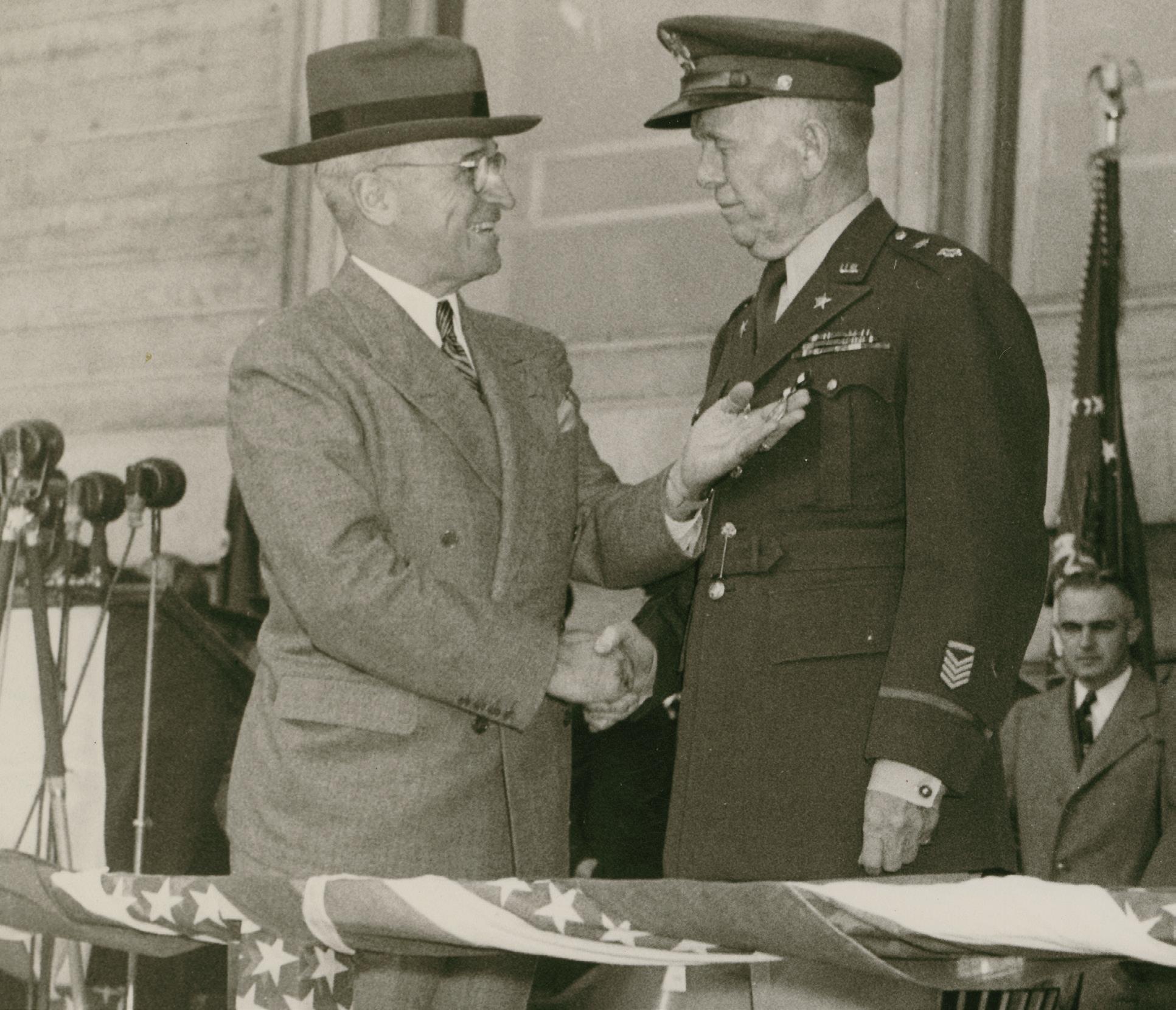
29
Truman awards Marshall an Oak Leaf Cluster, November 26, 1945.
“In all my contacts with Marshall I found him as a rule coolly impersonal, with little humor. He could laugh, but he never gave evidence of a deep-seated pleasure in life…. It was typical of him that no one I knew, with the exception of General Stilwell, ever called him by his Christian name or was on terms of even the beginnings of familiarity with George Catlett Marshall.”
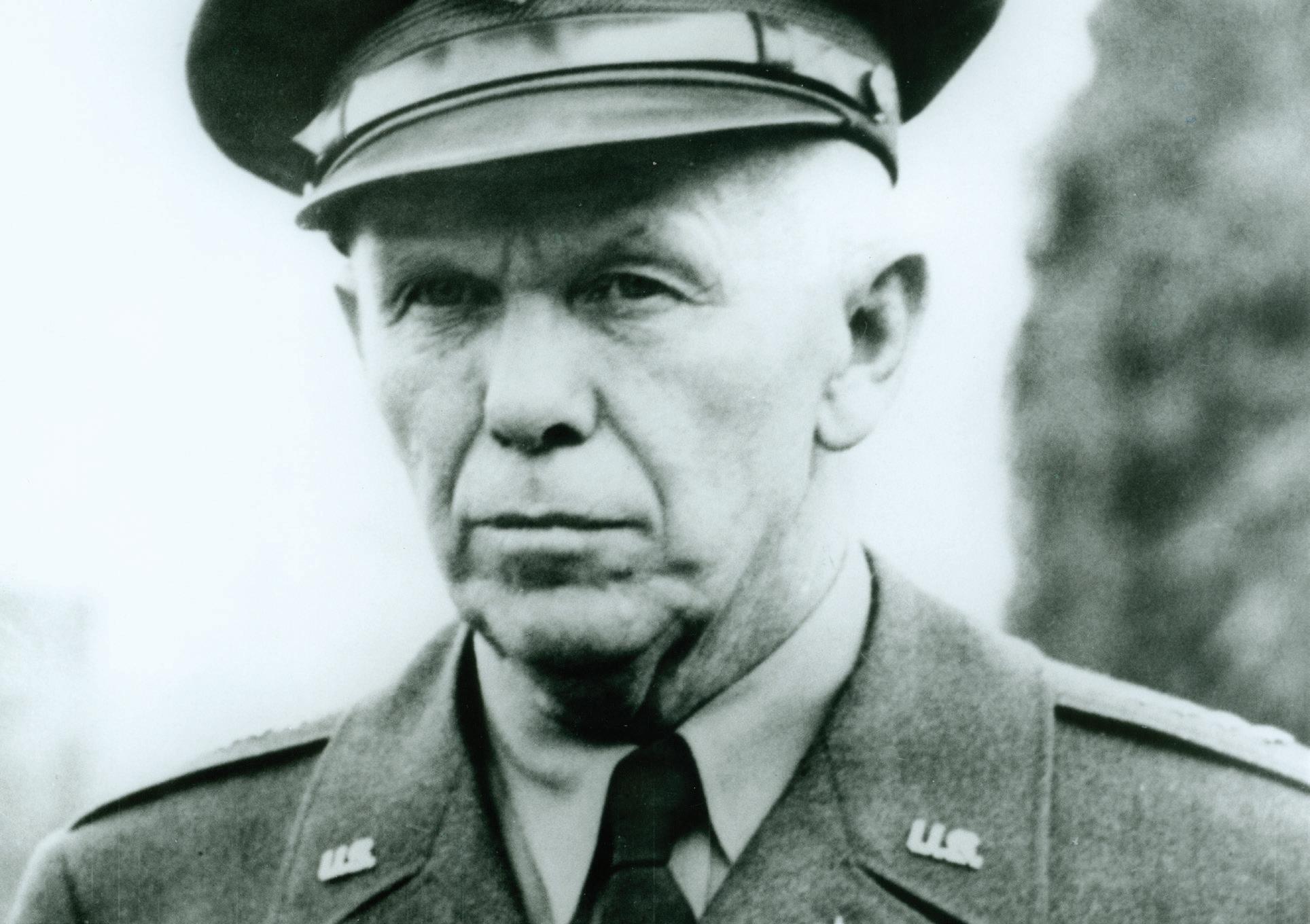
30
Albert C. Wedemeyer, 1958
Gen. Marshall glowers during a trip to France, likely June, 1944.
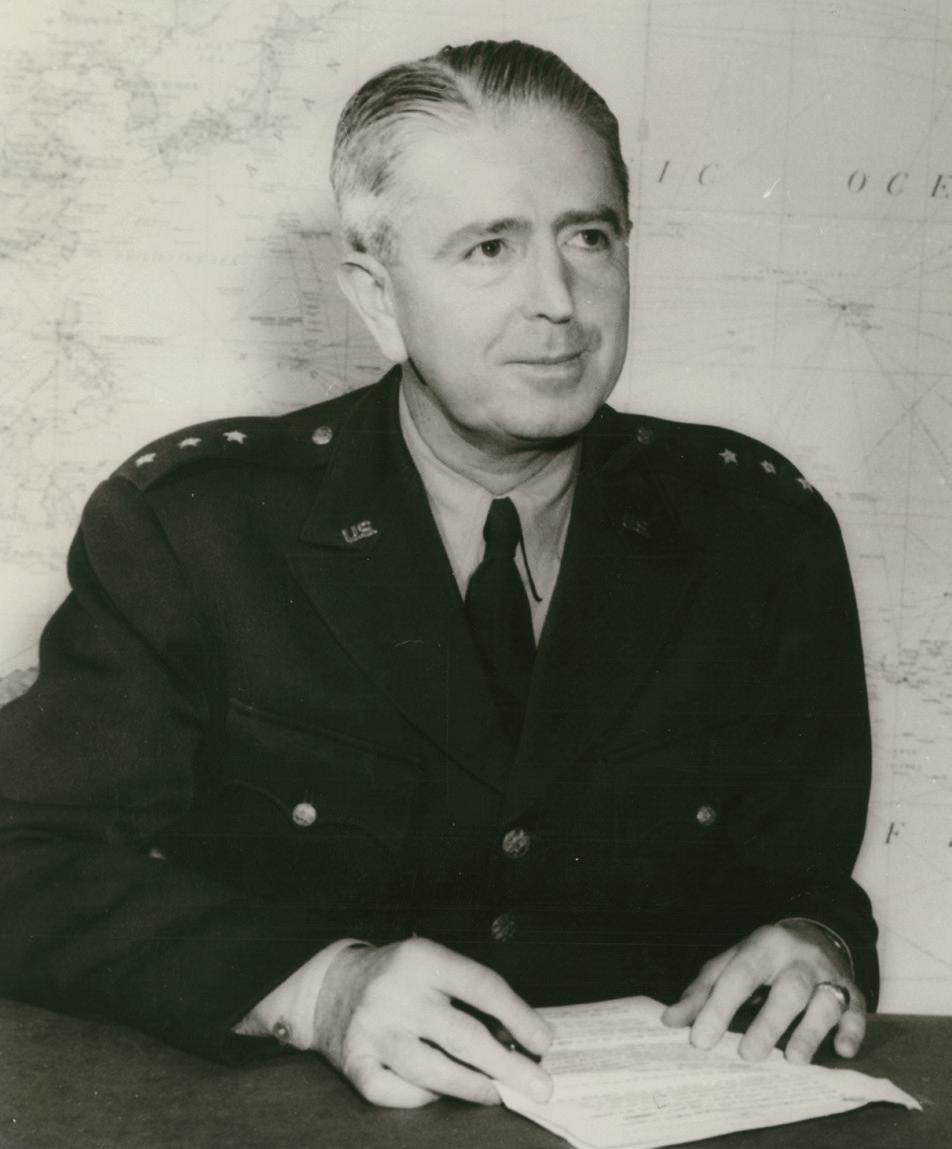
After graduating in 1919 from the U.S. Military Academy, Albert Coady Wedemeyer began his military career training in armored warfare in Germany. As a specialist in German tactical operations, Wedemeyer’s “most ardent student” was George Marshall.
Wedemeyer worked closely with Army Chief of Staff Marshall throughout World War II. Initially he created the Victory Program in 1941 on behalf of General Marshall for the “overall production requirements required to defeat our potential enemies.” In 1942, Wedemeyer accompanied General Marshall to London to discuss military troop buildup in the United Kingdom. A year later, Wedemeyer was reassigned to the South-Asia Theatre before Marshall directed him to China to assume command of U.S. forces in the country, replacing General Joseph Stilwell.
The mission in China attempted to support the Nationalist government under Generalissimo Chiang Kai-shek and to bring the Communists under Mao Zedong into a united front against the Japanese. With Marshall as his boss, the two men communicated regularly and professionally. On July 10, 1945, Wedemeyer wrote to Marshall, saying if both sides made “realistic concessions,

serious post-war disturbance may be averted….” Those disturbances were not averted. Marshall soon replaced Wedemeyer as Special Envoy to forestall a continuing civil war between the Nationalist and Communist forces.
Despite Marshall’s and Wedemeyer’s close interactions, there was no hint of friendliness between the two. Marshall characteristically lost his sense of humor when entering the office as a means of efficiency in his serious line of work, and he chose his friends carefully. President Truman could be considered a friend of Marshall’s –President Roosevelt could not. In an infamous discord between Marshall and Roosevelt in 1938, the president called him “George,” which Marshall later remembered, “I don’t think he ever did it again.”
Like Roosevelt, Marshall never allowed Wedemeyer to see his out-of-the-office personality, one which was known by others to have been friendly, animated, and loving. The jolly grandfather in Marshall was put aside when serious business had to be taken care of because, as Marshall warned, “I cannot afford the luxury of sentiment, mine must be cold logic.”
31
Left: Portrait of Gen. Albert C. Wedemeyer
Right: Secretary of State Marshall smiles broadly testifying before the Senate Appropriations Committee, March 23, 1948.
Procession at Harvard, June 6, 1947
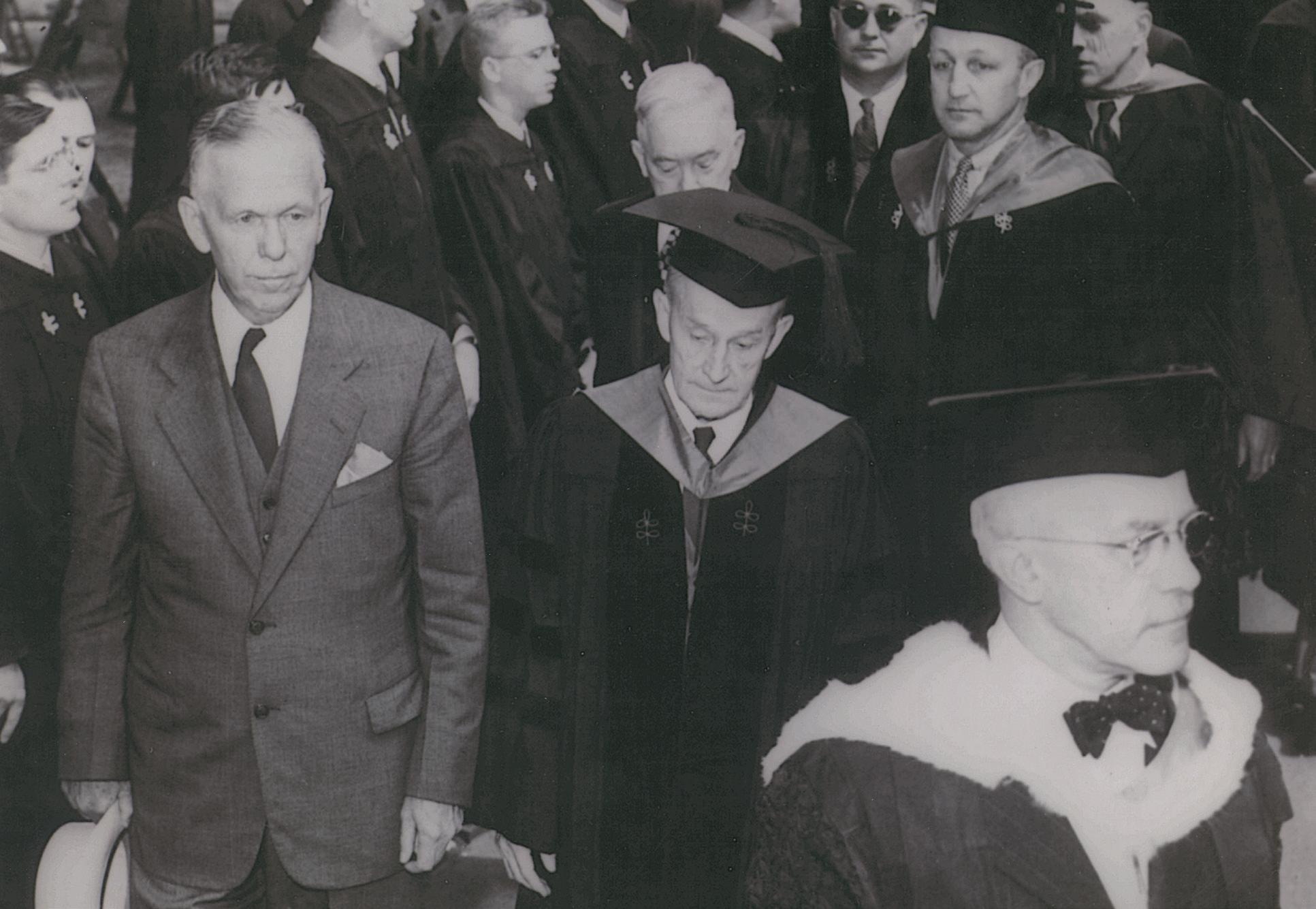
“Olympian in his moral quality.”
Charles P. Kindleberger, 1973
In a speech given at Harvard University on June 6, 1947, Secretary of State Marshall changed the course of American history and international foreign policy. His speech outlined a plan to help rebuild postwar Europe, which at the time lay in ruins with the threat of Communist expansion looming. Marshall warned, “Europe’s requirements for the next three or four years of foreign food and other essential products … are so much greater than her present ability to pay that she must have substantial additional help or face economic, social, and political deterioration of a very grave character.” With a plan proposed to initiate
joint economic revitalization, European enthusiasm poured in, and the Marshall Plan was born.
Although the program bears his name, Marshall was not the only one who created it. Most of the work fell to his army of State Department staff for design and execution, especially William L. Clayton and George F. Kennan, while Marshall lobbied Congress and the American people for support. “It was a struggle from start to finish because all America was opposed to appropriating anything,” said Marshall.
Support finally came, and the Marshall Plan was signed into law on April 3, 1948. The halls
32

of the State Department buzzed with skilled civil servants bringing this vision to life. One such servant was Charles P. Kindleberger, a distinguished economist. Kindleberger was serving as Acting Director of the Office of Economic Security Policy when he was chosen to begin assisting on the Marshall Plan in 1947. The first work in economics on computers was done on the Plan by Kindleberger on borrowed Pentagon machines.
While working at the State Department, Kindleberger worked closely with Marshall, staying up all night at times to accomplish the day’s goals. His firsthand account of Marshall’s lead-
ership style and personality is unique but telling of the secretary of state’s character: “Marshall himself was a great, great man—funny, odd but great—Olympian in his moral quality.” Marshall was known to have a sense of humor when not working, but the greatest comparison made here is between Marshall and godhood. His modesty and strict adherence to his own code of integrity made Marshall a bipartisan icon of strength and honor. Perhaps Marshall was not a god, but are those not the qualities of one?
Secretary of State Marshall testifies before Congress in support of the European Recovery Plan (Marshall Plan).
33
“In
Marshall’s presence ambition folds its tent.”
Anonymous British official, October 16, 1959
As with all generals, their tour of duty must come to an end. George C. Marshall died of complications due to a stroke on October 16, 1959, after forty-nine years of selfless public service. His funeral ordered no lying-in state, no funeral in Washington National Cathedral, and a private burial ceremony with no eulogy. Among the short list of pallbearers named by Marshall, Robert Lovett was requested “if it is convenient.” News of Marshall’s passing elicited tributes and memorials across the world, including the one quoted above. Perhaps Marshall’s greatest tribute came not from friends, fellow soldiers, or even Americans, but from a British radio broadcaster named Alistair Cooke. A resident of the U.S. since 1937, Cooke hosted “Letters from America,” a weekly radio series which after 2,869 in-

stallments, became the longest-running speech radio program hosted by one individual. His shows analyzed topical issues in the U.S., and on October 16, 1959, it was General Marshall whom Cooke sought to memorialize.
“I hope I won’t be misunderstood if I say that he was the most un-American figure because he was so remarkably self-effacing,” said Cooke. “He was a man whose inner strength and secret humor only slowly dripped through the surfaces of life, as a stalactite hangs stiff and granity [sic] for centuries before one sees beneath it a pool of still water of marvelous purity.” Cooke continued for fifteen minutes in his radio eulogy of the general, after which he ended with a humorous story of Marshall refusing $1 million to write his memoirs, a poignant reminder of the self-effacement

34
Left: Alistair Cooke, 1974. (Library of Congress photo) Right: Marshall’s casket being carried into Fort Meyer chapel
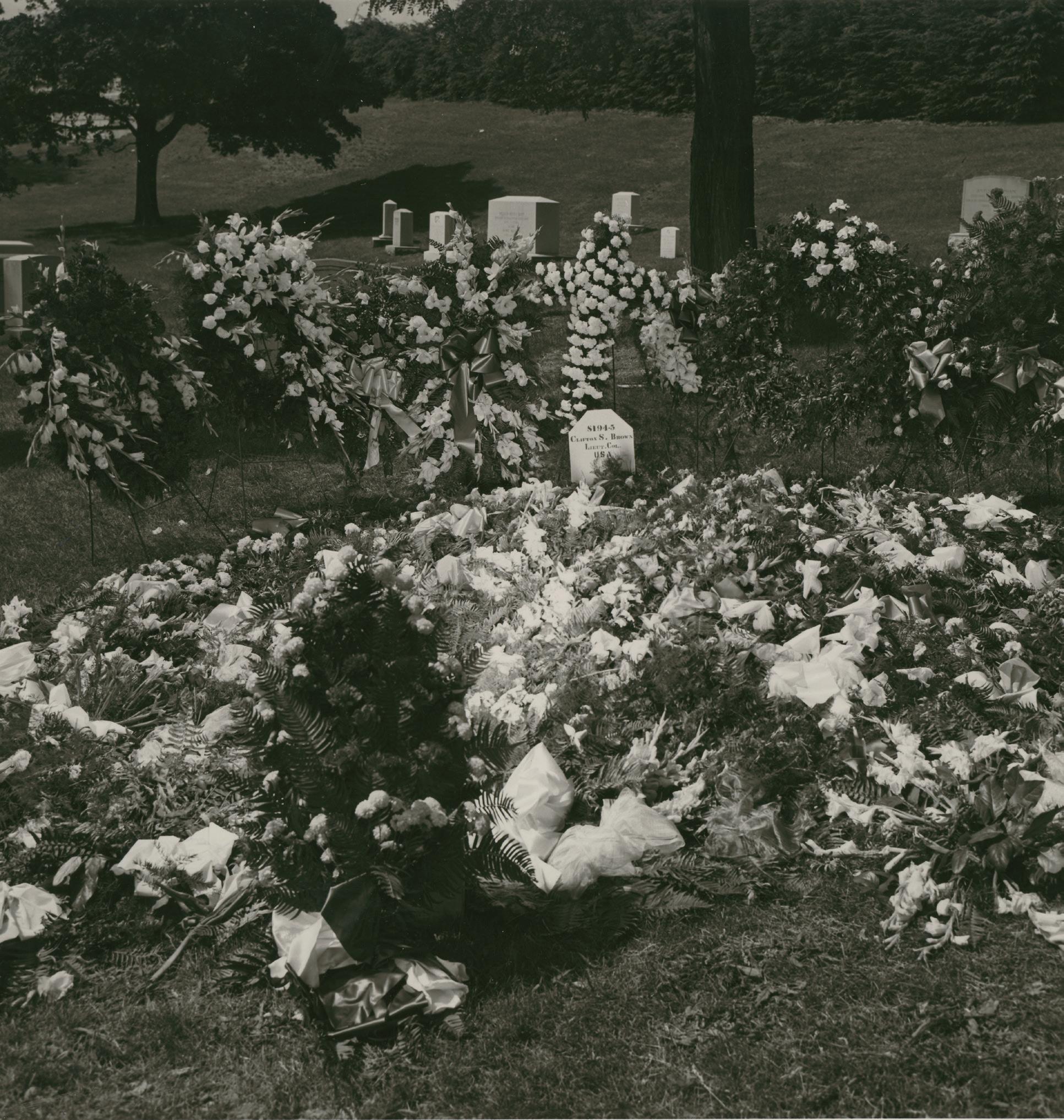
Alistair Cooke was not the only one who spoke of Marshall’s character. Winston Churchill called him “The noblest Roman of them all,” and Dean Acheson relied on the work of Plato to eloquently describe Marshall’s integrity and virtue. Today the prestige of this great man continues, albeit only in the words of biographies. Indeed, Marshall’s life spanned seventy-eight short years, but his legacy lives on eternally.
35
Cooke so rightly admired.
Cody Youngblood is an architectural historian and the curator at Patrick Henry’s Red Hill. Youngblood holds an M.A. in the conservation of historic buildings from the University of York and has formerly served as museum director of Marshall’s home, Dodona Manor, in Leesburg, Virginia.
Flowers at Marshall’s grave at Arlington National Cemetery following his funeral
HAPPY BIRTHDAY, GENERAL MARSHALL
George Marshall was born Dec. 31, 1880—the last day of the last year of the decade. In his reminiscences with biographer Forrest Pogue, Marshall recalled with great detail childhood Christmases celebrated with his family, but did not mention his birthdays. Perhaps he had the problem of many children born during the holidays-Christmas and birthday get wrapped into one. He certainly could have commiserated over this issue with
by Melissa H. Davis
friend and associate Field Marshal Sir John Dill, who was born on Christmas.
We do know a bit more about Marshall’s birthdays as an adult, but his long years of public service meant that he didn’t often get to celebrate his birthday at home with his family.
In 1925, Lt. Col. Marshall was serving near Tientsin, China, on his birthday. His first wife Lily and her mother helped him celebrate. In a letter to friend Brig. Gen. John McAuley Palmer,
36
MARSHALL TURNS 142
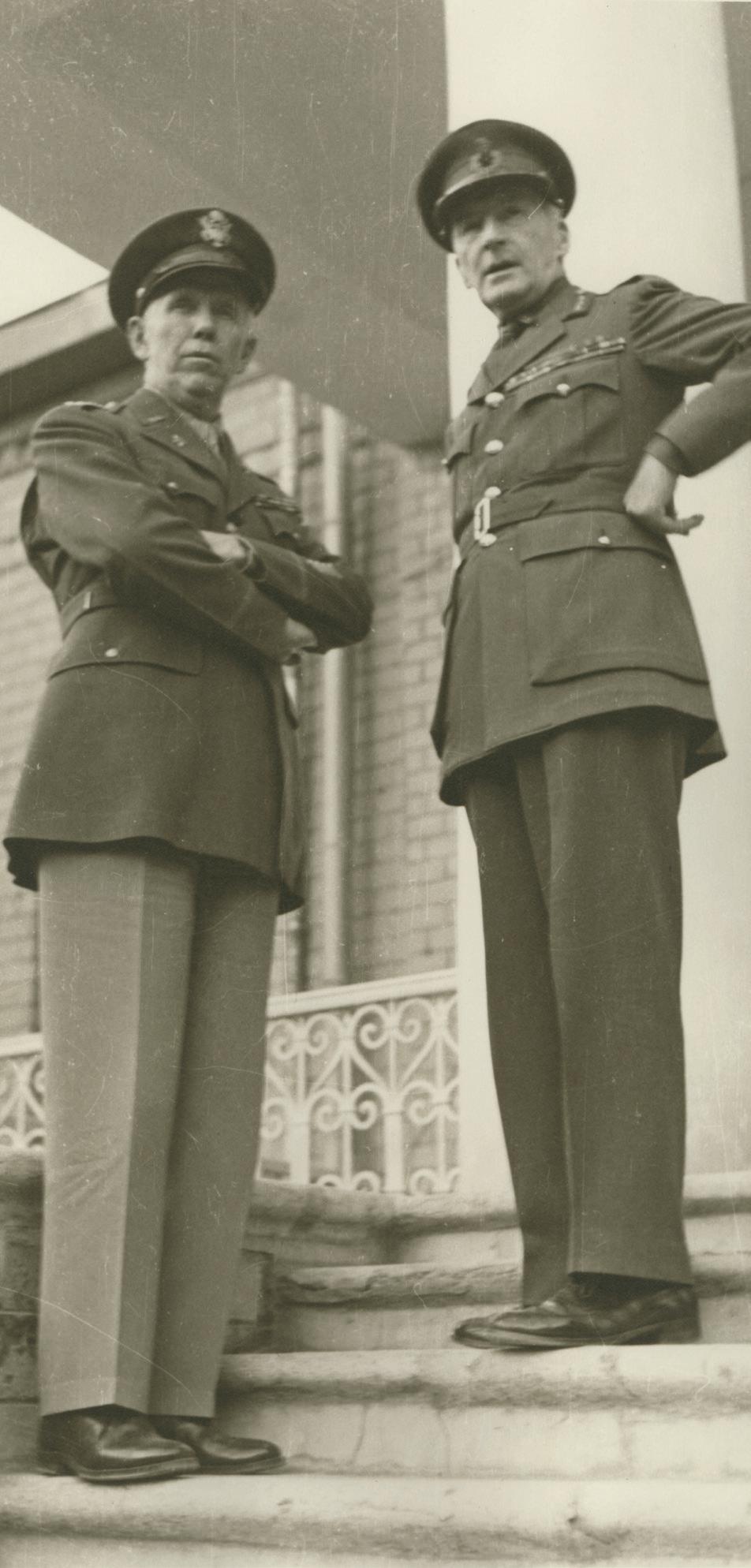
Marshall writes, “Today is my 45th birthday. I’m no longer of the ‘Young Turk’ party. Isn’t that sad after the bombast and assurance of our Leavenworth days of Army reformation.”
In 1940, Marshall was at Quarters 1 at Fort Myer, his home while chief of staff of the army. He enjoyed “a riding party breakfast with which we were celebrating the event, though why celebrate my increasing yearage is really a question,” he wrote to friend Ruth Adams.


In 1942, he was surprised at lunchtime in his new office at the Pentagon with a party attended by members of Marshall’s immediate staff, chief subordinates, Secretary Stimson, Assistant Secretary McCloy, and Field Marshal Dill. Secretary Stimson gave a toast: “I feel, General Marshall, that you are one of the most selfless public officials whom I have ever known. In spite of your deep feelings and affections you have always been able to consider first the requirements of the job
37
Left: George C. Marshall and Field Marshal Sir John Dill at the Tehran Conference in November 1943 Top: Children bring Marshall presents at his birthday dinner at the home of Generalissimo and Madame Chiang Kaishek, December 31, 1946.
Bottom: Marshall sitting with dignitaries at his birthday dinner
Marshall, family and friends prepare to cut the cake at Marshall’s 75th birthday, December 31, 1955.
and to disregard all other considerations.”
In 1946, he was in China on his birthday, and celebrated with Chinese Nationalist leader Chiang Kai-shek and his wife, Madame Chiang Kai-shek. Katherine had already departed for home by way of the territory of Hawaii, where Marshall would soon meet her.
In 1955, Marshall celebrated his 75th birth-
day at Liscombe Lodge, the winter home he and Katherine had in Pinehurst, North Carolina, joined by family and friends. There was a large cake with candles to blow out; and nearby Fort Bragg sent its army band to serenade Marshall on his big day.
Happy birthday, General Marshall!

Melissa has been at GCMF for three years, and previously was an academic librarian specializing in history. She and her husband, John, have three grown children, and live in Rockbridge County with large rescue dogs. Keep up with her @MelissasLibrary.
38
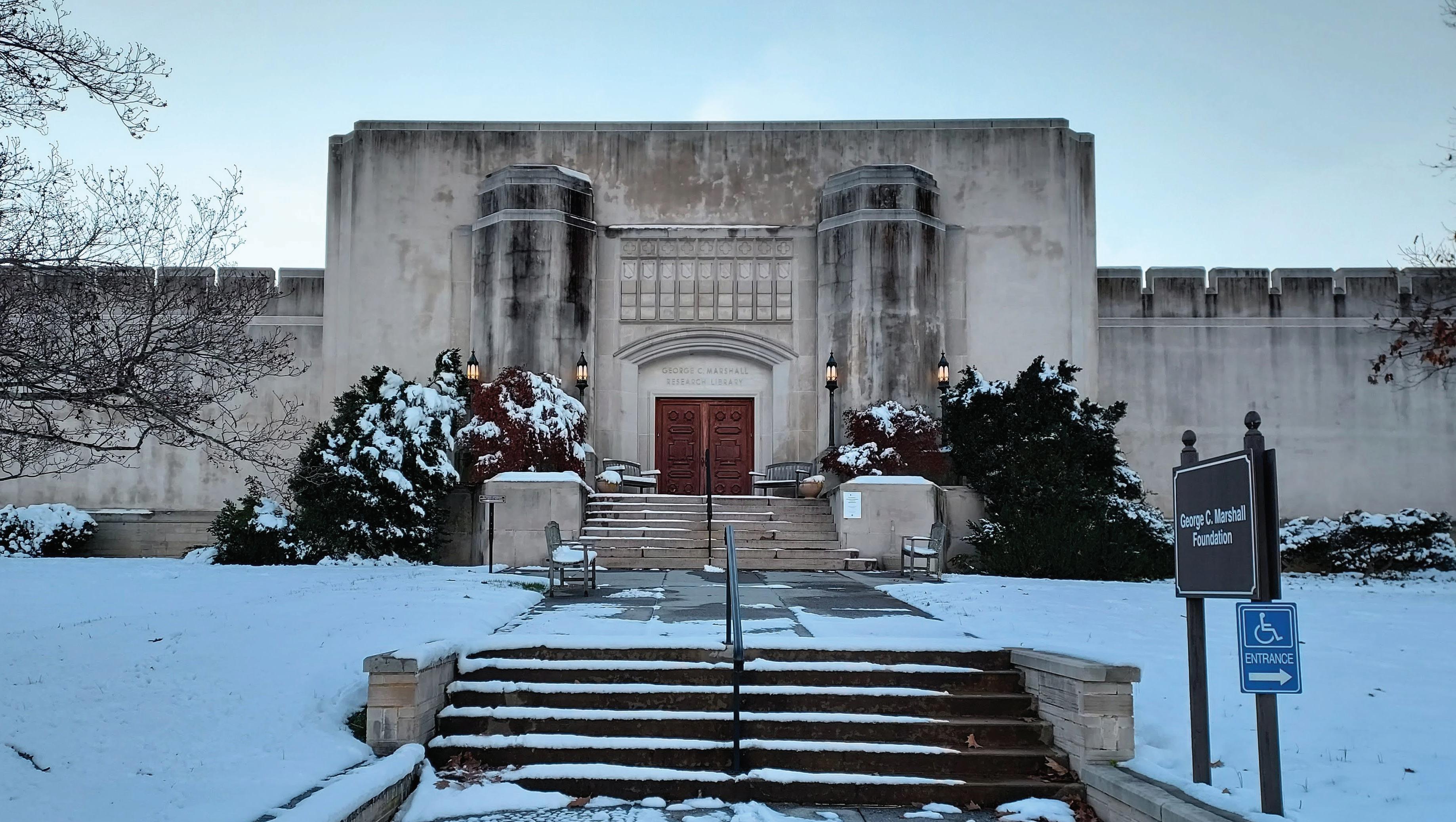
FOUNDATION STAFF
Glen J. Carpenter Director of Communications and Multimedia gcarpenter@marshallfoundation.org
Melissa Davis Director of Library and Archives mdavis@marshallfoundation.org
David Hein Senior Fellow hein@hood.edu
Alice J. Lee Special Projects Assistant leeaj@marshallfoundation.org
Paul A. Levengood President plevengood@marshallfoundation.org
Leigh H. McFaddin Associate Director of Development and Special Events mcfaddinlh@marshallfoundation.org
Matthew M. Waldron
Chief Administrative Officer and Chief Financial Officer mwaldron@marshallfoundation.org
John J. Wranek III Director of Development jwranek@marshallfoundation.org
BOARD OF TRUSTEES (2022)
C. Russell Fletcher, III Chairman
John B. Adams, Jr.
Hunter A. Applewhite
Richard A. Cody
Madison F. Cole, Jr
George W. Foresman
Walton M. Jeffress, Jr.
Andrew G. Kumpuris
Paul A. Levengood
Cynthia Marsteller
Jessine A. Monaghan
Thomas A. Pritchard
Peter Prowitt
Maria P. Rasmussen
David L. Roll
Bennett L. Ross
James M. Schmuck
Alston P. Watt
Michael A. Williams
James J. Winn, Jr.
Cedric T. Wins
Robert G. Woodward
COUNCIL OF ADVISORS
Nancy K. Baker
Mark Baruch
Julius W. Becton, Jr.
Ann L. Brownson
Thomas S. Burack
Christine K. Carrico
Robert B. Charles
Richard B. Cheney
William E. Dreyer
Charles W. Dyke
P. Wesley Foster, Jr.
Gregory P. Gass
David Hein
Thomas H. Henriksen
Paul R. Ignatius
Walter H. Kansteiner, III
John M. Keane
UPCOMING EVENTS
John W. Knapp
William J. Lemon
Constance A. Morella
Thomas R. Morris
Charles W. Payne, Jr
L. F. Payne, Jr.
Thomas R. Pickering
Kurt A. Polk
James E. Rogers
Gordon R. Sullivan
Richard F. Timmons
Carl E. Vuono
Harry H. Warner
Olin L. Wethington
Samuel B. Witt III
Clifford Miller Yonce
John H. Zentay
Virtual Legacy Lecture by Leah Garrett: February 23
Legacy Lecture by Maj. Gen. Mari K. Eder: March 9
Legacy Lecture by Chris Gorham: April 20
39


P.O. Box 1600, Lexington, VA 24450



 Paul A. Levengood, President
Paul A. Levengood, President














































